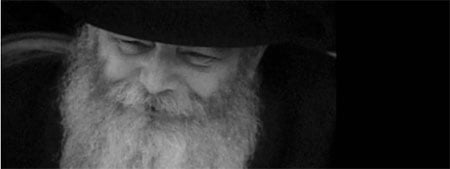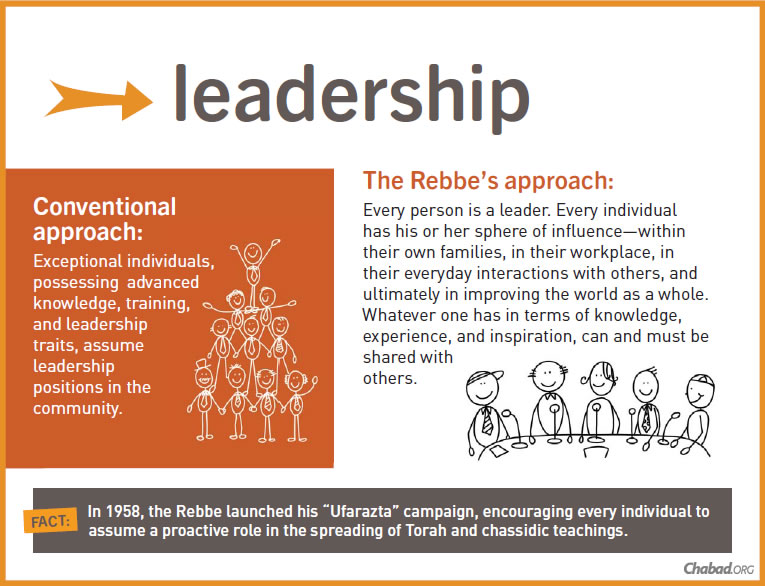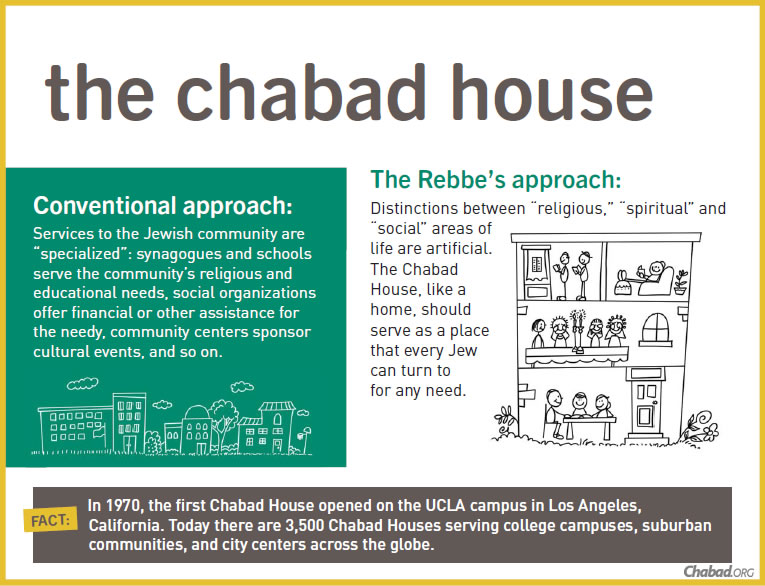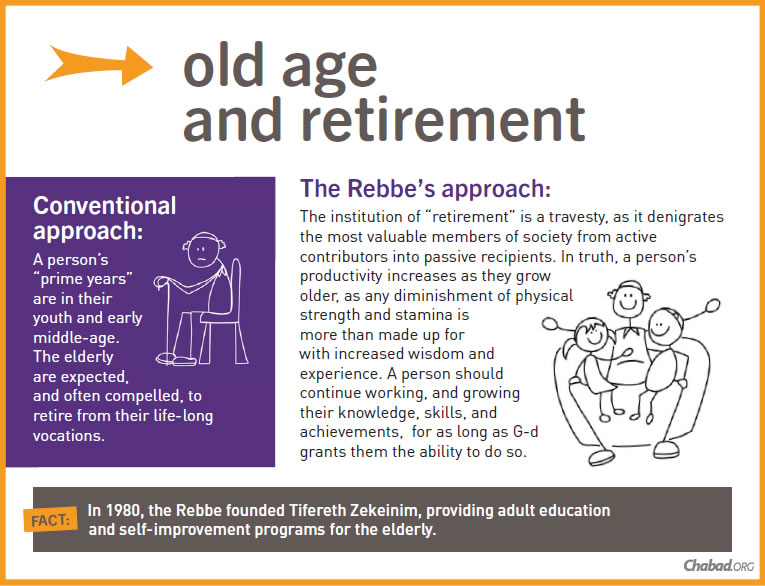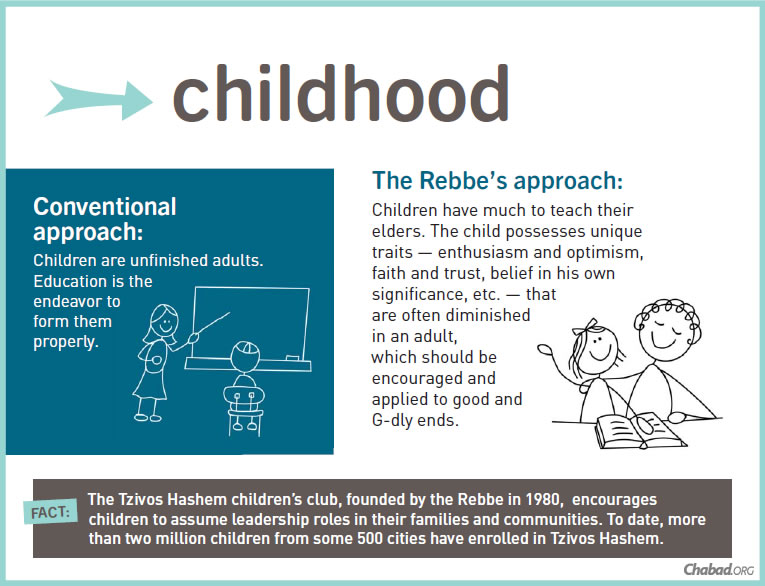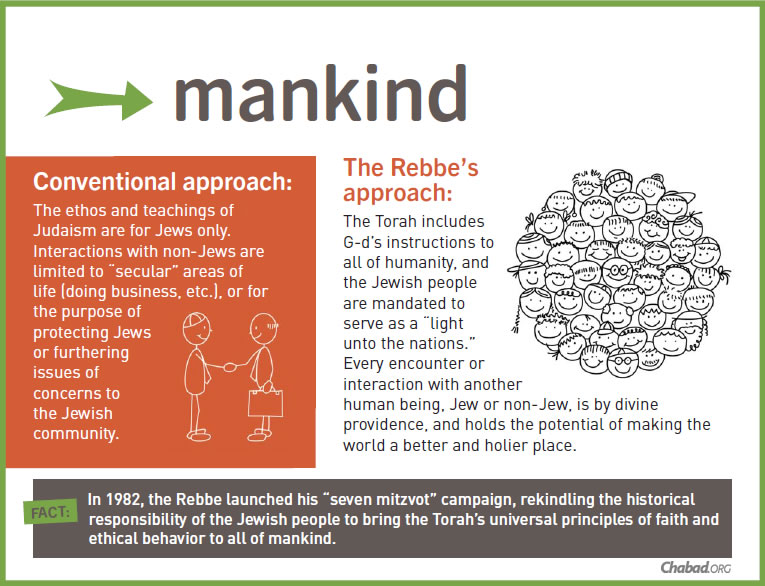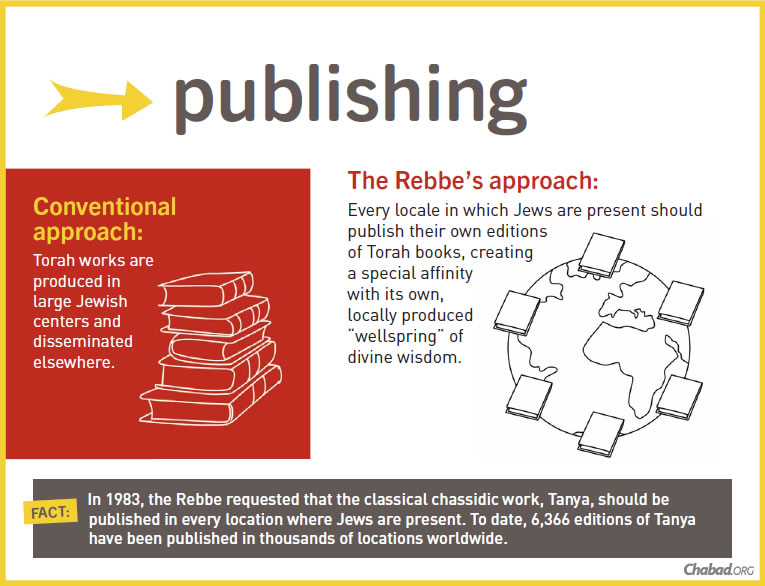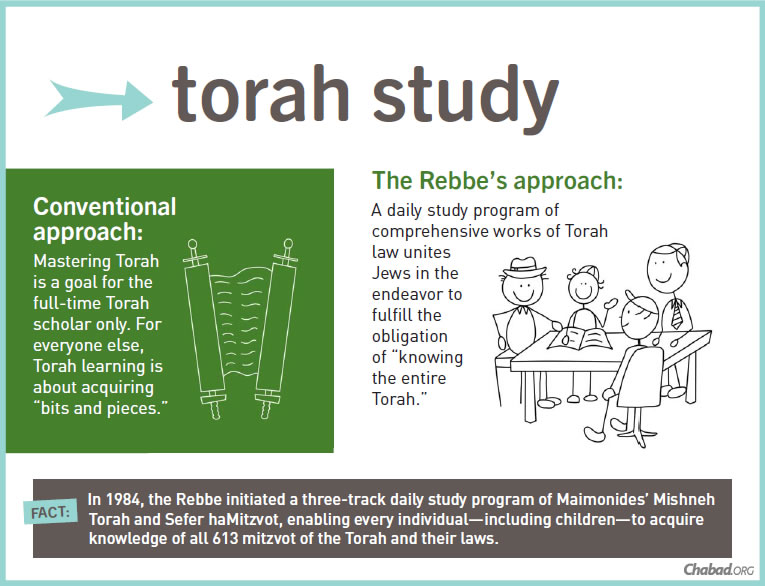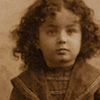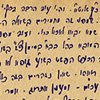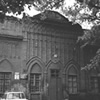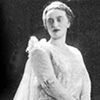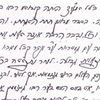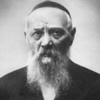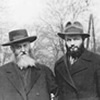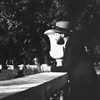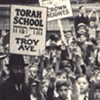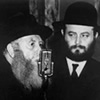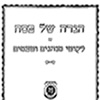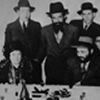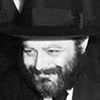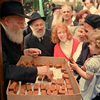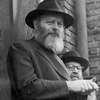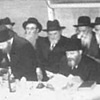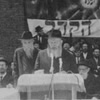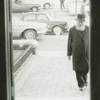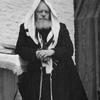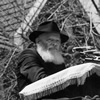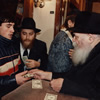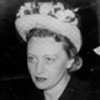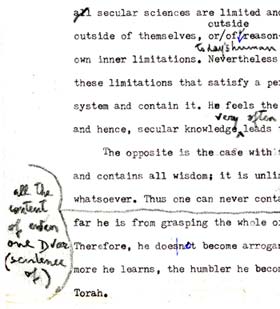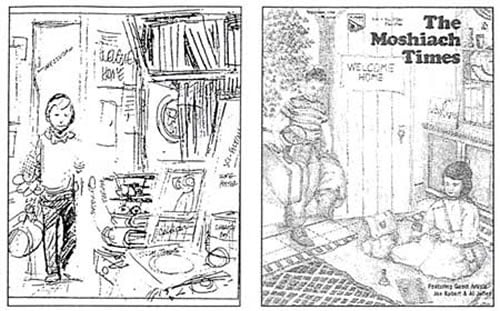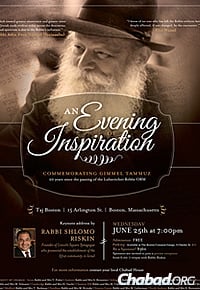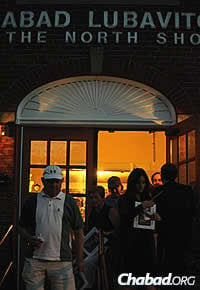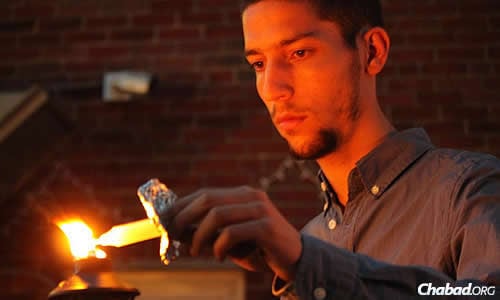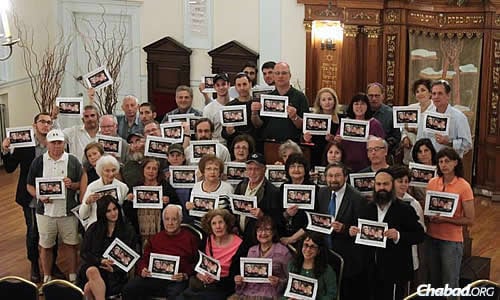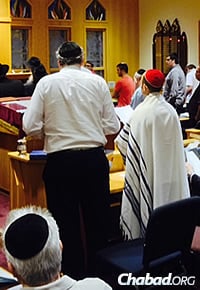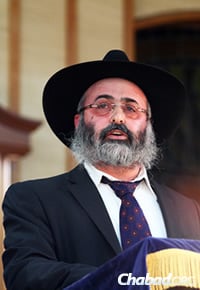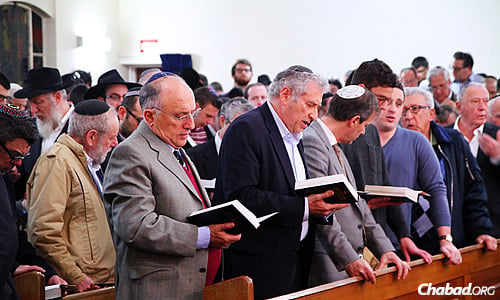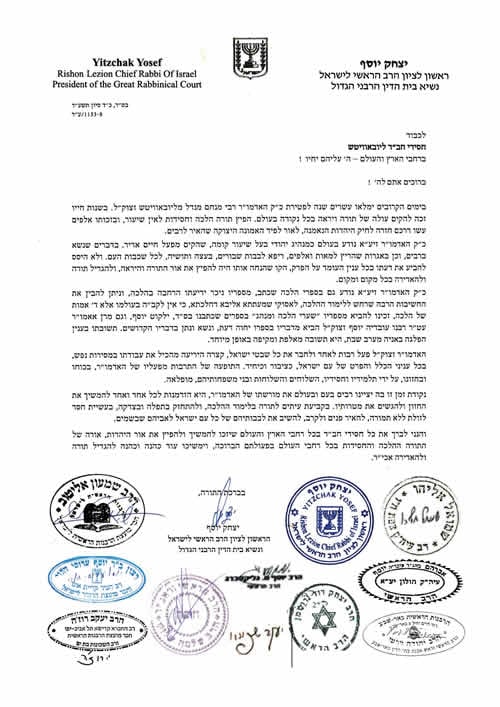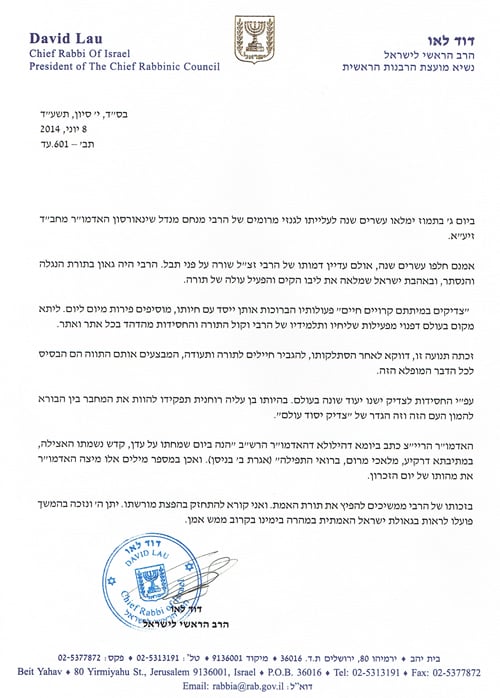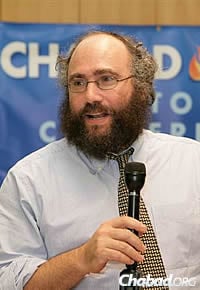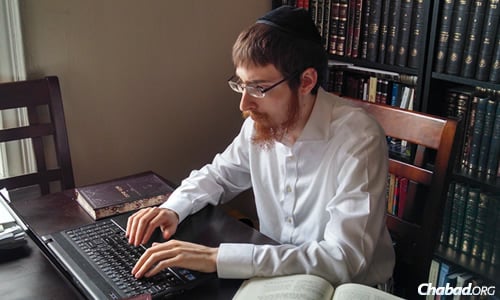Chabad Magazine for Monday, Tammuz 2, 5774 • June 30, 2014
Editor's Note:
Dear Friend,
We are currently marking the 3rd of Tammuz, the 20th anniversary of the passing of the Rebbe—Rabbi Menachem M. Schneerson, of righteous memory.
In Aramaic, an anniversary of passing is often called a hillula, which literally means “celebration.”
A celebration on the day of passing? The mystics explain that on the day a righteous person passes away, his Torah scholarship and good deeds are revealed in an elevated state, which makes this day a deeply meaningful and joyful one for all of his disciples.
And we are all disciples of the Rebbe.
If you are reading this e mail, your life has been influenced by the Rebbe’s teachings. If you’ve ever stepped into a Chabad center, you too have been touched by the Rebbe’s abounding love for every Jewish person. If you’ve visited our site (like 37 million others this past year alone), you’ve benefited from the Rebbe’s embrace of technology as a medium through which G d’s presence can be spread to all parts of earth.
If you think about it, the underlying factor of the Rebbe’s multifaceted leadership was his drive to transform our world into a place where G d will feel at home. So, let us commemorate the day of his yahrtzeit by continuing his mission, adding more mitzvahs and good deeds. Together, we can make his dream a reality.
Rabbi Mendy Kaminker,
on behalf of the Chabad.org Editorial Team
Daily Thought:
High Souls
To one whose self is his body, death of the body is death of the self. But for one whose self is his love, awe and faith, there is no death, only a passing. From a state of confinement in the body, he makes the passage to liberation. He continues to work within this world, and even more so than before.
The Talmud says that Jacob, our father, never died. Moses, also, never died. Neither did Rabbi Judah the Prince. They were very high souls who were one with Truth in an ultimate bond—and since Truth can never die, neither could they.
Yes, in our eyes we see death. A body is buried in the ground, and we must mourn the loss. But this is only part of the falseness of our world. In the World of Truth, they are still here as before.
And the proof: We are still here. For if these high souls would not be with us in our world, all that we know would cease to exist
This Week's Features:
Marking 20 Years Since the Rebbe's Passing
Essays, insights and letters, stories and first-person accounts, and an online biography of the Lubavitcher Rebbe, Rabbi Menachem Mendel Schneerson, of righteous memory
http://www.chabad.org/therebbe/default_cdo/jewish/The-Rebbe.htm
3 TAMMUZ
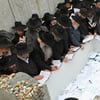 What To Do On 3 Tammuz
What To Do On 3 Tammuz
Six Simple Suggestions for the 20th anniversary of the Rebbe’s passing
On the anniversary of a tzadik’s passing, all the light that he planted in this world—his teachings, good deeds, and everything in which he invested his life and being—all this shines brightly, so that anyone connected to him can receive blessings of life, happiness and wisdom.
How should we spend such a day? How do we make that connection?
Here are six simple suggestions:
If you’re the type that likes to go all the way, skip to our Insider’s Guide to the Third of Tammuz.)
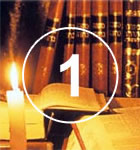
1. Learn
Best connections are mind-to-mind. Make some of those by visiting our special collection of essays, videos and a live online class—and plug your mind into the Rebbe’s ideas.
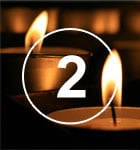
2. Pray
Make the light real. On Monday evening, June 30th, light a 24-hour candle, as is customary on the anniversary of a close one’s passing. Even if you don’t regularly attend services, try to get to your local Chabad House the Shabbat before, and/or on the actual day.
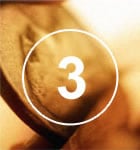
3. Give
Partner with one of the Rebbe’s institutions, either at home, in Israel, or abroad, by making a donation that day.
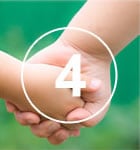
4. Do
Check out the Ten-Point Mitzvah Campaign that the Rebbe initiated. See how you can expand your involvement in any of those mitzvahs. Encourage another Jew to do the same. As the Rebbe would often say, any one mitzvah can transform the entire world.

5. Write
Write a letter to be placed at the resting place of the Rebbe that day using our online form. Ask him to help you open the gates of heaven’s blessings—for you, your family and friends at this special time. Mention the resolutions you have made today, and the positive influence you’ve had on others.

6. Spread the Word
Make a time to sit with your family and talk about the Rebbe, his accomplishments and his vision, and the mission he gave each one of us to prepare this world for the times of Moshiach.
APPRECIATING THE REBBE'S CONTRIBUTION
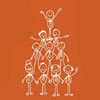 Unconventional Wisdom
Unconventional Wisdom
A graphic sampling of the Rebbe’s revolutionary teachings and initiatives
By Yanki Tauber
________________________________________
More in Appreciating the Rebbe's Contribution:
• Scholar, Visionary and Leader (By Eli Rubin)

In the recent and not-so-recent past, many letters, documents, interviews and books have been published, in addition to the many volumes of the Rebbe’s own teachings. But the sheer wealth of available material makes it difficult to get a brief and systematic view of what most significantly contributes to the Rebbe’s lasting influence as a scholar, visionary and leader.Torah scholarship, philosophical vision and communal leadership . . . a single narrative.
Each of the twenty-eight articles in this series encapsulates a different period of the Rebbe’s life, and highlights key themes that distinguish his ideas. Drawing on the Rebbe’s public talks, private journals, and other primary sources, as well as on many excellent interviews conducted by Jewish Educational Media, this series weaves threads of the Rebbe’s Torah scholarship, philosophical vision and communal leadership into a single narrative.
This is by no means an exhaustive treatment, but a series of snapshots designed to provide rich insight, detail and color.
• The Divinity of Torah (By Yanki Tauber)
What is Torah? The various definitions and characterizations that appear in the Torah itself and in the teachings of the sages give rise to a fundamental paradox regarding its essential nature and function. This fundamental paradox forms a cornerstone of the Rebbe’s approach to the study and understanding of Torah.
In his formulation of the thirteen principles of the Jewish faith, Maimonides writes:
The eighth principle is the divinity of the Torah. That is: We believe that this entire Torah which we now have is the one given by Moses our teacher, and is entirely from the mouth of the Almighty . . . There is no difference between the verses, “The children of Ham: Kush and Mitzrayim and Phut and Canaan,”1 “The name of his wife was Mehetabel the daughter of Matred,”2 or “Timna was a concubine,”3 and the verses, “I am G‑d your G‑d”4 or “Hear O Israel, G‑d is our G‑d, G‑d is one.”5 For it is all from the mouth of the Almighty, all G‑d’s Torah—whole, pure and holy.6
Maimonides also emphasizes that not only the “Written Torah” (i.e., the five books transcribed by Moses) is divine, but also the “Oral Torah”—the entire body of interpretation and exposition which accompanies it.7 In the words of the Talmud,
Scripture, Mishnah, Talmud and Agadah, even what a proficient pupil is destined to innovate, was already said to Moses at Sinai.8
Rabbi Schneur Zalman of Liadi writes:
The Torah is the wisdom and will of G‑d . . . For it arose in His will that when, for example, Reuben will argue such-and-such, and Simeon will argue such-and-such, the verdict as between them should be such-and-such. Even if this particular case never was and will never be . . . nevertheless, since it has arisen in the wisdom and will of the Holy One, blessed be He, that if this one argues such, and the other argues such, the ruling should be such, then the person who understands and apprehends with his mind this ruling as a law that is presented in the Mishnah or the Talmud or the works of the halachic authorities—that person apprehends and grasps and encompasses within his mind the wisdom and will of G‑d, which no thought can grasp except when they are clothed within the laws that have been presented to us . . .9
On the most basic level, defining the Torah as “the wisdom and will of G‑d” establishes its absolute veracity and immutability.10 A prevalent theme in the Rebbe’s teachings is that the divinity of Torah also implies that the finite and mortal human mind is incapable, in and of itself, of apprehending it. Rather, Torah must be given to us. It is only because G‑d has chosen to “clothe” His infinite and essentially supra-rational wisdom and will “within the laws that have been presented to us” that we are capable of studying and understanding Torah. R. Abahu in Shemoth Rabbah cites the verse (Exodus 31:18) “He gave to Moses, when He finished speaking with him on Mount Sinai, the two tablets of testimony . . .” and expounds:
For the entire 40 days that Moses was above, he would learn Torah and forget. Said he to Him: “Master of the world! I have spent forty days, and I do not know a thing!” What did G‑d do? He gave him the Torah as a gift, as it says, “He gave to Moses . . .”11
Thus, throughout the writings of the sages, the revelation at Mount Sinai is referred to “the giving of the Torah.” We acknowledge this in the “blessing on the Torah” recited each morning: “Blessed are You, G‑d our G‑d, sovereign of the world, who has chosen us from all the nations and has given us His Torah; blessed are You, G‑d, who gives the Torah.”12 The Talmud declares: “Why was the land lost? Because they did not recite the blessing which precedes the study of Torah.”13 The failure to recite the blessing that acknowledges the “Giver of the Torah” is no minor infraction of law and custom, but one that goes to the very heart of what Torah is: a divine gift rather than a human achievement.14The finite and mortal human mind is incapable, in and of itself, of apprehending the divine wisdom
Accordingly, the Rebbe would often emphasize, a most important prerequisite for the study and acquisition of Torah is bitul, or self-abnegation.15 The Talmud states: “Why are the words of Torah compared to water? To tell you that just as water forsakes a high place and travels to a low place, so do the words of Torah endure only in one who is of a humble mind.”16 “An empty vessel can retain” that which is poured into it; “a full vessel cannot retain.”17 The study of Torah requires its student to engage the faculty that is the crowning glory of the human being—the intellect; yet an equally crucial requirement is that the person empty himself of the arrogance and pretension that a human mind—even the most astute and accomplished of human minds—is capable of apprehending the infinite and supra-rational mind of G‑d. The knowledge of and understanding of Torah is a divine gift, bestowed on those who approach its study with the humility and the commitment to “conceive, understand, listen, learn, teach, keep and do”18 that which G‑d desires of us.
The Talmud notes that the Torah begins with the letter ב (beit)—the second letter of the Hebrew alphabet. Would it not have been more appropriate to begin with the first letter, א (aleph)? A number of answers are given by the sages of Talmud as well as by the later commentaries.19 The Rebbe analyzes a number of these explanations and points to their common denominator: that the study of Torah is predicated on an awareness of its divine source. Before we read the very first letter of the text of the Torah, we acknowledge the unseen aleph that precedes its opening beit—a reality higher than intellect, a truth beyond what can be expressed in letters and words.20
The Al Hanisim prayer, which summarizes the story of Chanukah, describes the Hasmonean revolt against the Greeks as a battle with those who sought “to make them forget Your Torah, and to make them transgress the statutes of Your will” (להשכיחם תורתך ולהעבירם מחוקי רצונך). The wording of this key phrase, says the Rebbe, is significant, and is fundamental to understanding the history, miracle and observances of Chanukah:
The objective of the Hellenist decrees was to make the Jewish people forget Your Torah—the divinity and supra-rationality of Torah. They had no objection to Jews studying the intellect and wisdom of Torah; all they wanted was that this study should be devoid of any sense that this is G‑d’s Torah. Similarly, they sought to eradicate the statutes of Your will—that Jews should not fulfill the “statutes” (chukim), the Torah commandments that are supra-rational,21 and which are fulfilled out of simple obedience, solely because they are “Your will,” the will of G‑d.22
The Rebbe also applies this concept to explain a mysterious passage in the Talmudic account of the giving of the Torah. The Talmud23 examines the verses (Exodus 19:1–16) which describe the events An empty vessel can retain that which is poured into it, a full vessel can notleading up to the revelation at Mount Sinai, deducing from these verses what transpired each day from when the children of Israel arrived in the Sinai Desert on the first day of the month of Sivan until the giving of the Torah on the sixth (or seventh24) day of that month. On each of these days there were specific divine communications, and/or specific actions undertaken by the people, in preparation for their receiving of the Torah from G‑d. Regarding the first day of Sivan, however, the Talmud states that on this day Moses “did not say anything at all to them, because of the weariness of the journey.” This is most puzzling, in light of the fact that from the time that they left Egypt, six weeks earlier, the people were in a state of heightened anticipation for the giving of the Torah. They literally counted the days, and devoted each day to the refinement of another aspect of their character in preparation for the event that would constitute the fulfillment and purpose of their liberation from Egyptian slavery (a count and process of self-refinement which we reenact each year with the 49-day “counting of the Omer” from Passover to Shavuot). One would expect that the day on which they arrived at the site at which the Torah would be given to them would be a day of heightened activity and preparation.
The Rebbe explains that Moses’ silence and the seeming non-activity of the people on the first of Sivan were in fact a crucial preparation for the giving of the Torah. This was a day devoted to stilling the ever-active, ever-assertive human mind and transforming it into a recipient of Torah. This is the “wearying journey” of which the Talmud speaks: not the short trek from Rephidim to Sinai,25 but the spiritual and intellectual journey of making the most achievement-oriented of human faculties—the mind and intellect—into the “empty vessel” that can apprehend the essentially supra-rational truths of Torah.26
FOOTNOTES
1.Genesis 10:6.
2.Ibid. 36:39.
3.Ibid. 36:12.
4.The first of the Ten Commandments (Exodus 20:2).
5.Opening verse of the Shema (Deuteronomy 6:4).
6.Maimonides’ commentary on the Mishnah, introduction to Perek Chelek.
7.See Maimonides’ introduction to Mishneh Torah, and the opening chapters of his introduction to his commentary on the Mishnah. For more on the “Written Torah” and the “Oral Torah” and how these two aspects of Torah relate to the paradox under discussion in this chapter, see chapter 5 below, “The ‘Written Torah’ and the ‘Oral Torah.’”
8.Jerusalem Talmud, Pe’ah 2:4; see footnote # 10 in chapter 6 below. Cf. Talmud, Megillah 19b: “G‑d showed Moses the expositions of the Torah, the exposition of the sages, and that which the sages are destined to innovate.”
9.Tanya 1:4.
10.As articulated in the eighth and ninth of Maimonides’ “Thirteen Principles.”
11.Shemoth Rabbah 41:6.
12.See also text of the Kidush and the Amidah prayers for the festival of Shavuot; Talmud, Berachoth 5a; Bereishith Rabbah 6:5; et al.
13.Talmud, Nedarim 81a, based on Jeremiah 9:11–12.
14.Likutei Sichoth, vol. 15, p. 3, based on Bach, Orach Chayim 47.
15.Likutei Sichoth, vol. 15, pp. 324–330, et al.
16.Talmud, Taanit 7a.
17.Talmud, Berachot 40a.
18.From the blessing preceding the reading of the Shema.
19.I.e., that the ב of בראשית, “In the beginning . . . ,” is preceded by, and subservient to, the א of אנכי ה׳ אלקיך, “I am G‑d your G‑d . . .” (R. Acha in Bereishith Rabbah 1:10); that the Torah speaks to the realm of בריאה, “creation,” the second “world” of the seder hishtalsheluth, antecedent to which is the realm of אצילות, “emanation” (Ari, Likutei Torah, Bereishith); that the account of creation with which the Torah opens addresses the plurality of the created reality—the letter ב signifying the number 2—whereas the Torah as given by G‑d embodies the divine unity expressed by the letter א (Maharal, Tif’ereth Yisrael 34).
20.The Rebbe, Likutei Sichoth, vol. 15, pp. 1–6.
21.The commandments of the Torah fall under three general categories: a) mishpatim, rationally self-evident “laws”; b) eidoth, comprehendible “testimonials”; and c) chukim, supra-rational “statutes.”
22.Likutei Sichoth, vol. 3, p. 815, et al.
23.Shabbat 88a.
24.As per the two opinions cited in the Talmud, ibid.
25.The Rebbe notes that according to the Talmud’s calculations, the day that the children of Israel arrived in Sinai was a Sunday or a Monday, and they had already been commanded not to travel on the Shabbat (see Exodus 16:29).
26.Likutei Sichoth, vol. 28, pp. 7–14. Also see footnote #6 in chapter 3 below.
VIDEO
 How to Bring the Rebbe’s Message into Our Daily Lives
How to Bring the Rebbe’s Message into Our Daily Lives
A farbrengen in preparation for the Rebbe’s 20th yahrtzeit, with Rabbi Mendel Lipskier
By Mendel Lipskier
Watch (1:00:00)
<script language="javascript" type="text/javascript" src="http://embed.chabad.org/multimedia/mediaplayer/embedded/embed.js.asp?aid=2599275&width=auto&height=auto"></script><div style="clear:both;">Visit <a href="http://www.chabad.org/multimedia/default_cdo/aid/591213/jewish/Video.htm">Jewish.TV</a> for more <a href="http://www.chabad.org/multimedia/default_cdo/aid/591213/jewish/Video.htm">Jewish videos</a>.</div>
________________________________________
More in Video:
• Just the Person to Talk To (Rabbi Dr. Tzvi Hersh Weinreb)
http://www.chabad.org/therebbe/livingtorah/player_cdo/aid/2618592/jewish/Just-the-Person-to-Talk-To.htm
http://www.chabad.org/2618592
• “He, Too, Is Alive”
<script language="javascript" type="text/javascript" src="http://embed.chabad.org/multimedia/mediaplayer/embedded/embed.js.asp?aid=690704&width=auto&height=auto"></script><div style="clear:both;">Visit <a href="http://www.chabad.org/multimedia/default_cdo/aid/591213/jewish/Video.htm">Jewish.TV</a> for more <a href="http://www.chabad.org/multimedia/default_cdo/aid/591213/jewish/Video.htm">Jewish videos</a>.</div>
PARSHAH
 Peaceful Coexistence
Peaceful Coexistence
Parshat Balak
How do we reach true unity?
By Chaya Shuchat
E pluribus unum, “Out of many, one,” the Seal of the United States proclaims, but as any politician can tell you, that’s easier said than done. Unity between people of diverse cultures and backgrounds is hard to achieve. As idealistic as we may be, we all have unique needs and desires which can be difficult to forgo for the sake of the common good.
So, how do we reach true unity?
This week’s Torah portion sheds some light on this issue. In Parshat Balak, Bilaam, a gentile prophet, conveys a vision of the future Redemption: “A star How do we reach true unity?will go forth from Jacob, and a staff will arise from Israel, which will crush the princes of Moab and uproot all the sons of Seth.”1
That sounds kind of extreme. Why would Moshiach, the leader of a peaceful and utopian era, start uprooting and destroying nations? A world that is peaceful only for the chosen few hardly seems like an ideal worth striving for.
And how are we to understand this prophecy in the context of other prophecies of redemption that describe the nations of the world serving G‑d together? In the book of Zephaniah, for example, it is written, “For then I will convert the peoples to a pure language, that all of them will call in the name of the L‑rd, to worship Him of one accord.”2
Furthermore, Bilaam’s prophecy states that Moshiach will “uproot all the sons of Seth.” Seth was the third son of Adam and Eve. Their first son, Abel, was murdered, and all of Cain’s descendants were wiped out in the Great Flood. Thus, all of mankind descends from Seth. This verse cannot possibly be interpreted literally, because if Moshiach would eliminate all the sons of Seth, nobody would be left.
The Lubavitcher Rebbe offers this interpretation: When Moshiach comes, there will be an unprecedented revelation of G‑dliness, leaving no room for evil or impurity. All people in the world will readily accept G‑d’s rule upon themselves, because His presence will be so obvious. And this is the “uprooting” that the verse refers to—the uprooting of our selfish tendencies, our egotistical desires and motivations.
Yet there are two ways in which this uprooting can take place. It is possible to imagine the rise of a leader so powerful, with a vision so compelling, that the entire world becomes subservient to him. In such a world, everyone behaves in an exemplary fashion—there is no killing, no theft, no discrimination, no selfishness. But these tendencies have not really been uprooted; they’ve merely been suppressed. As long as these beliefs and values do not become integrated into our own psyche, our own worldview, the redemption is incomplete.
The leadership of Moshiach will be different. It will not be an imposition from outside, but the culmination of a process of refinement that has been going on since the beginning of exile. Over the centuries of exile, the Jewish people have not just been wandering from place to place. We have also been painstakingly laying the seeds for the future Redemption—by infusing holiness wherever we went, through our observance of Torah and mitzvahs.
When the world and all that is in it will perceive G‑d of its own accord, when everyone will call out to G‑d in their own voice, then there will be true Redemption. This is the key to true unity—when our individual experiences and talents all contribute to a common goal.
On a personal level, I sometimes encounter people whose views are so offensive, whose behavior is so frustrating, that I wish they would just disappear. But individuals who are truly beyond redemption are extremely rare. I could focus on our areas of The leadership of Moshiach will be differentdisagreement and try to convince them to move toward my viewpoint, or worse, condemn them for their wrongness. But all this does is add to the general discord. A more effective approach would be to focus on our common ground and cultivate the good that is within others.
In 1991, in the aftermath of the Crown Heights riots, New York City mayor David Dinkins visited the Rebbe and requested a blessing for the people of “all our communities.” The Rebbe responded, “. . . Forget that it is ‘both sides.’ It is one side, one people . . .”3
Unity among nations is within our reach. It may take effort, but by looking beyond superficial differences, we can see the many ways that we are one. Redemption is not a far-off dream, but a fast-approaching reality.
(Based on an address of the Lubavitcher Rebbe, Likkutei Sichot, vol. 23, p. 172.)
FOOTNOTES
1.Numbers 24:17.
2.Zephaniah 3:9.
3.www.chabad.org/1599198.
________________________________________
More in Parshah:
• Of Donkeys and Discernment (By Shlomo Yaffe)
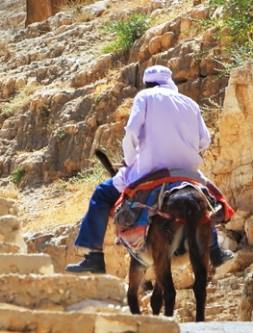
In one of the most fascinating stories in the Torah, the prophet Balaam tries get G‑d to acquiesce to his desire to curse the Jewish people, thereby causing them some harm that would weaken or destroy them. Balak, the king of Moab, had offered him great reward if he would weaken the people of Israel so they could be driven away from the region.
Balaam engages in a series of dialogues with G‑d, in which G‑d makes it clear that He doesn’t want Israel cursed. Balaam, however, thinks he can still “sell” G‑d on the idea.
Then, Balaam’s donkey moves from being a mere conveyance to an eloquent spokescreature for animal rights. Three times she sees an angel blocking the way. Each time she moves aside—angering Balaam, who did not see the angel. Each time, Balaam hits the poor donkey. Finally, in the Torah’s words,Balaam’s donkey becomes an eloquent spokescreature for animal rights
G‑d opened the mouth of the she-donkey, and she said to Balaam, “What have I done to you that you have struck me these three times?”
Balaam said to the she-donkey, “For you have humiliated me; if I had a sword in my hand, I would kill you right now.”
The she-donkey said to Balaam, “Am I not your she-donkey on which you have ridden since you first started until now? Have I been accustomed to do this to you?”
He said, “No.”
G‑d opened Balaam's eyes, and he saw the angel of G‑d standing in the road, with a sword drawn in his hand. He bowed and prostrated himself on his face.
The angel of G‑d said to him, “Why have you beaten your she-donkey these three times? Behold, I have came out to thwart you . . .”
The biblical commentator Rashi points out the donkey seeing the angel is not at all remarkable: “The she-donkey saw, but [Balaam] did not see, for G‑d permitted a beast to perceive more than a man. Since [man] possesses intelligence, he would become insane if he saw the threatening angel.”
This idea expressed by Rashi is an embodiment of the key lesson of the entire Balaam episode.
The question is often asked: why did G‑d originally argue with Balaam, telling him that He disapproved of the trip, only to let him go and try to curse Israel, and eventually foiling his plot? Why didn’t He just stop Balaam in his tracks?
The Talmud (Makkot 10b) answers this question:
One is allowed to follow the road he wishes to pursue, as it is written, “G‑d said to Balaam, ‘You shall not go with them,’” and then it is written, “If the men came to call you, rise up and go with them.”
The essence of humanity is free will. Free will is the “image of G‑d” in which Adam and Eve were created.We can, and alas often do, use the beautiful mural of our lives merely to wrap old fish heads
The Source of All has defined absolute moral and conceptual principles. Living a life that expresses these principles is the definition of goodness. At every juncture, however, we are completely free to reject such a mode of life. This freedom gives substance and meaning to our choice when we “choose life.”
On rare occasions we are given a glimpse of the truth (such as at Sinai), just so that we know what it is that we seek. But freedom of choice can truly exist only in an environment of natural ignorance that demands discernment and intelligence to overcome. We must live in a world where neither Creator nor creation is obvious. We are then given the ability to use our powers of intelligent analysis and discernment to recognize that this magnificent mural has an Artist, and that our being painted into this mural means that our presence is of fundamental necessity for the entire enterprise of creation to be whole.
We can, of course, deny the beauty and purpose of the painting, and remain in the state of ignorance we are born into. We can, and alas often do, use the beautiful mural of our lives merely to wrap old fish heads before throwing them into the trash. We can use our incredible powers of discernment and intelligence to attain the superficial and ephemeral, all the while making each other miserable in 101 ingenious ways. Balaam can listen to G‑d or not; he can be grateful for his donkey, or repay the benefits he has received with evil—by beating her.
As we all remember, the pauper in Mark Twain’s The Prince and the Pauper was using the desperately sought Seal of the Realm to crack nuts, oblivious to its true value as the nation’s symbol of authority and law.
If we saw the process of creation and the presence of the G‑dly in everything, if we saw the flow of energy from the Infinite Source into everything, bringing it into being at every moment, we would have no free choice in choosing the good; it would be obvious.
Malach, the Hebrew word for “angel,” simply means “messenger.” An angel is a vehicle that carries life force to a particular entity and situation, like a specific “packet” of information on the Internet carrying information from the server to a specific IP address. In a metaphorical sense, the angel blocking Balaam’s path was G‑d giving Balaam the information to intuit that this particular road trip was a bad idea. The donkey sees this reality and accepts it as matter of course; were we to see it, it would circumvent our intellect and choice, and force us to accept the reality of the G‑dly presence.
Hence, an animal possessed of no free will or abstract intelligence can see all. Balaam’s donkey was not overwhelmed by the vision of the spiritual forces that drive everything, because it is unaffected by the cognitive implications of this fact. That is a fine way of life—for a donkeyShe does not need the tools of intelligence that provide us humans with a grasp of the implications of that which we see.
We are given discernment and intelligence to autonomously pierce the veil of ignorance cast over humanity, if we so choose. To do so, this veil must remain locked in place until we open it by using the keys we are given.
Often people say, “If G‑d would appear to me, and tell me to, I would live a life according to the Torah.” That is a fine way of life—for a donkey. Besides, as events demonstrated, even after Balaam got to see things from the donkey’s perspective, it did not help him; he kept following the “way he wished to be led.”
G‑d has given us something far, far superior to “Donkeyvision”: the challenge of liberty and the gift of discernment.
• Leadership & Loyalty (By Rabbi Jonathan Sacks)

Is leadership a set of skills, the ability to summon and command power? Or does it have an essentially moral dimension also? Can a bad man be a good leader, or does his badness compromise his leadership? That is the question raised by the key figure in this week’s Parshah, the pagan prophet Balaam.
First, by way of introduction, we have independent evidence that Balaam actually existed. An archeological discovery in 1967, at Deir ’Alla at the junction of the Jordan and Jabbok Can a bad man be a good leader?rivers, uncovered an inscription on the wall of a pagan temple, dated to the eighth century BCE, which makes reference to a seer named Balaam ben Beor, in terms remarkably similar to those of our Parshah. Balaam was a well-known figure in the region.
His skills were clearly impressive. He was a religious virtuoso, a sought-after shaman, magus, spellbinder and miracle worker. Balak says, on the basis of experience or reputation, “I know that whoever you bless is blessed, and whoever you curse is cursed.”1 The rabbinic literature does not call this into question. On the phrase “No prophet has risen in Israel like Moses, whom the L‑rd knew face to face,”2 the sages went so far as to say: “In Israel there was no other prophet as great as Moses, but among the nations there was. Who was he? Balaam.”3
Another midrashic source says that “there was nothing in the world that the Holy One, blessed be He, did not reveal to Balaam, who surpassed even Moses in the wisdom of sorcery.”4 At a technical level, Balaam had all the skills.
Yet the ultimate verdict on Balaam is negative. In chapter 25 we read of the ironic sequel to the episode of the curses/blessings. The Israelites, having been saved by G‑d from the would-be curses of Moab and Midian, suffered a self-inflicted tragedy by allowing themselves to be enticed by the women of the land. G‑d’s anger burns against them. Several chapters later (31:16) it emerges that it was Balaam who devised this strategy: “They were the ones who followed Balaam’s advice and were the means of turning the Israelites away from the L‑rd in what happened at Peor, so that a plague struck the L‑rd’s people.” Having failed to curse the Israelites, Balaam eventually succeeded in doing them great harm.
So the picture that emerges from the Jewish sources is of a man with great gifts, a genuine prophet, a man whom the sages compared with Moses himself—yet at the same time a figure of flawed character that eventually led to his downfall and to his reputation as an evildoer, one of those mentioned by the Mishnah as having been denied a share in the world to come.5
What was his flaw? There are many speculations, but one suggestion given in the Talmud infers the answer from his name. What is the meaning of Balaam? Answers the Talmud: it means “a man without a people” (belo am).6
This is a fine insight. Balaam is a man without loyalties. Balak sent for him, saying: “Now come and put a curse on these people, because they are too powerful for me . . . For I know that those you bless are blessed, and those you curse are cursed.” Balaam was a prophet for hire. He had supernatural powers. He could What was his flaw?bless someone, and that person would succeed. He could curse, and that person would be blighted by misfortune. But there is no hint in any of the reports, biblical or otherwise, that Balaam was a prophet in the moral sense: that he was concerned with justice, desert, the rights and wrongs of those whose lives he affected. Like a contract killer of a later age, Balaam was a loner. His services could be bought. He had skills, and used them to devastating effect. But he had no commitments, no loyalties, no rootedness in humanity. He was the man belo am, without a people.
Moses was the opposite. G‑d Himself says of him, “He is [supremely] loyal in all My house.”7 However disappointed he was with the Israelites, he never ceased to argue their cause before G‑d. When his initial intervention on their behalf with Pharaoh worsened their condition, he said to G‑d, “O L‑rd, why do You mistreat Your people? Why did You send me?”8
When the Israelites made the golden calf and G‑d threatened to destroy the people and begin again with Moses, he said, “Now, if You would, please forgive their sin. If not, then blot me out from the book that You have written."9 When the people, demoralized by the report of the spies, wanted to return to Egypt, and G‑d’s anger burned against them, he said, “With Your great love, forgive the sin of this nation, just as You have forgiven them from [the time they left] Egypt until now.”10
When G‑d threatened punishment during the Korach rebellion, Moses prayed, “Will you be angry with the entire assembly when only one man sins?”11 Even when his own sister, Miriam, spoke badly about him and was punished by leprosy, Moses prayed to G‑d on her behalf: “Please, G‑d, heal her now.”12 Moses never ceased to pray for his people, however much they had sinned, however audacious the prayer, however much he was putting his own relationship with G‑d at risk. Knowing their faults, he remained utterly loyal to them.Moses never ceased to pray for his people
The Hebrew word emunah is usually translated as “faith,” and that is what it came to mean in the Middle Ages. But in biblical Hebrew it is better translated as “faithfulness, reliability, loyalty.” It means not walking away from the other party when times are tough. It is a key covenantal virtue.
There are people with great gifts, intellectual and sometimes even spiritual, who nonetheless fail to achieve what they might have done. They lack the basic moral qualities of integrity, honesty, humility, and above all, loyalty. What they do, they do brilliantly. But often they do the wrong things. Conscious of their unusual endowments, they tend to look down on others. They give way to pride, arrogance, and a belief that they can somehow get away with great crimes. Balaam is the classic example, and the fact that he planned to entice the Israelites into sin even after he knew that G‑d was on their side is a measure of how the greatest can sometimes fall to become the lowest of the low.
Those who are loyal to other people find that other people are loyal to them. Those who are disloyal are eventually distrusted, and lose whatever authority they might once have had. Leadership without loyalty is not leadership. Skills alone cannot substitute for the moral qualities that make people follow those who demonstrate them. We follow those we trust, because they have acted so as to earn our trust. That was what made Moses the great leader Balaam might have been but never was. Always be loyal to the people you lead.
FOOTNOTES
1.Numbers 22:6.
2.Deuteronomy 34:10.
3.Sifrei, Devarim 357.
4.Tanna d’Vei Eliyahu Rabbah 28. See also Bamidbar Rabbah 14:20, and Talmud, Berachot 7a and Avodah Zarah 4a.
5.Mishnah, Sanhedrin 10:2.
6.Sanhedrin 105a.
7.Numbers 12:7.
8.Exodus 5:22.
9.Exodus 32:32.
10.Numbers 14:19.
11.Numbers 16:22.
12.Numbers 12:13.
• Balak in a Nutshell
Balak, the king of Moab, summons the prophet Balaam to curse the people of Israel. On the way, Balaam is berated by his donkey, who sees, before Balaam does, the angel that G‑d sends to block their way. Three times, from three different vantage points, Balaam attempts to pronounce his curses; each time, blessings issue forth instead. Balaam also prophesies on the end of the days and the coming of Moshiach.
The people fall prey to the charms of the daughters of Moab, and are enticed to worship the idol Peor. When a high-ranking Israelite official publicly takes a Midianite princess into a tent, Pinchas kills them both, stopping the plague raging among the people.
QUESTIONS
 Can a Soulmate Be Stolen?
Can a Soulmate Be Stolen?
If you work on yourself, improve your character, and refine yourself to a new spiritual plane, then your soulmate changes.
By Aron Moss
Question:
A friend of mine says she is in no rush to get married, but feels pressured to “get out there” lest she miss out on her soulmate. I say that if it is meant to happen, it will. Who is right? Can your soulmate be “stolen” if you don’t act in haste?
Answer:
It is most certainly possible to miss out on your soulmate.
The Talmud discusses certain times of the year when Jewish law does not allow weddings to take place. One of them is during a festival, like Pesach, as we do not want one celebration to overshadow the other.
However, the Talmud says that while you can’t perform a wedding during a festival, you can make a shidduch—a match between prospective mates. The reasoning the Talmud gives is that while a wedding can wait until after the festival, if you delay making a match, someone else may beat you to your soulmate.
But how can one find a soulmate destined for someone else?
Through raising one’s soul to a higher level.
If you work on yourself, improve your character and refine yourself to a new spiritual plane, then your soulmate changes. A new, improved soul gets a new, improved soulmate.
And who will be that new soulmate? Someone whose original soulmate has either fallen to a lower spiritual level and doesn’t deserve that person anymore, or is dithering around, wondering if he or she is ready to get married . . .
Therefore, the two factors that can cause you to lose your soulmate are spiritual decline or lack of real effort. And the two factors that will most help you find your soulmate are self-improvement and determined effort.
Sit around, and nothing will happen. But as long as you are out there, and as long as you are working on yourself, you will find him.
Notes:
Talmud, Moed Katan 18b; Arizal, Shaar Hagilgulim, Hakdamah 8. For an in-depth discussion of preordained soulmates vs. human choice, please see Marriage: Destiny or Chance.
________________________________________
More in Questions:
• How to Intervene When You Witness a Wrong (By Simon Jacobson)
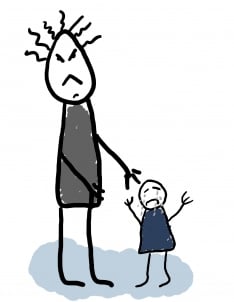 Sitting in a restaurant in New York City, I noticed a family eating at a table next to me. “How sweet,” I thought, “a nice couple taking out their three children on a beautiful night.” Until I noticed something very disturbing: The father was berating his young child, maybe 9–10 years old, and suddenly gave him a resounding slap on his face. I tried ignoring the scene and looking away, but the obvious tension around me made that very difficult, especially when the wife and husband began to argue. With every ensuing outburst, it became more and more obvious that this was not an anomaly; we were dealing with a dysfunctional family. It didn’t require any psychological training to see that these children were living in an abusive environment—with an angry father and a weak, helpless mother. The vibe was horrible. Can I make a move simply based on my instincts?I could feel the bitterness, rage and fear permeating the table near mine. I had no doubt that these innocent children were subject to an ongoing assault in their own home.
Sitting in a restaurant in New York City, I noticed a family eating at a table next to me. “How sweet,” I thought, “a nice couple taking out their three children on a beautiful night.” Until I noticed something very disturbing: The father was berating his young child, maybe 9–10 years old, and suddenly gave him a resounding slap on his face. I tried ignoring the scene and looking away, but the obvious tension around me made that very difficult, especially when the wife and husband began to argue. With every ensuing outburst, it became more and more obvious that this was not an anomaly; we were dealing with a dysfunctional family. It didn’t require any psychological training to see that these children were living in an abusive environment—with an angry father and a weak, helpless mother. The vibe was horrible. Can I make a move simply based on my instincts?I could feel the bitterness, rage and fear permeating the table near mine. I had no doubt that these innocent children were subject to an ongoing assault in their own home.
What to do? I simply could not tolerate sitting there just blithely biting into another piece of steak (or whatever delicacy was on my plate), indifferent to the pain being heaped upon these vulnerable children.
Should I approach the father and speak with him? He certainly would not welcome my gesture—a perfect stranger intervening in his personal business. But should that even matter? Should I sit by quietly while witnessing offensive behavior? Or perhaps my meddling will only provoke him further, taking it out on his family later? And after all, what can I say to an abusive man in a mere few minutes that will in any way help him and his children? Then again, is that a reason to just turn a blind eye fully cognizant of a crime being perpetrated? Should I be speaking to the wife and the children? Or alert authorities to the potential risk? Is that even ethical when I have no proof? After all, I did not know this family. I had no firsthand knowledge of what their home life was like. Can I make a move simply based on my instincts? On the other hand, perhaps I could prevent some damage being done?
You see—this is far from simple.
What would you do?
What would our forefather Abraham do?
The same question can be asked about every form of inappropriate behavior that we may witness. What is the right thing to do—to intervene or not?
You witness a coworker stealing money from your company. Do you ignore him, report him or confront him? You know that your neighbor is abusing his spouse. What action, if any, should you take?
The Torah lays out various guidelines as to our responsibility not to stand by silently and ignore the perpetration of a crime, as well as to warn others of potential danger. We also have an obligation to reprimand a sinful person, first privately and gently, and if that does not help, publicly. But applying these rules requires a case-by-case analysis. How, for instance, do these doctrines apply to the restaurant incident? If your intervention will not help solve the problem, and possibly even will exacerbate it, do you intervene? If you are not positive that a crime has been committed, can you pass judgment? After all, there is a due process that allows people the right of innocence until proven guilty. Can you act based on your “sense” that there is a serious problem?
In a previous article, I wrote about witnessing two people fighting in middle of synagogue services. I will share with you what I did in the synagogue, but first I will state a key principle, based on the Torah’s universal values and its extraordinarily sensitive approach to dealing with the human condition, epitomized by Abraham.
First and foremost, Abraham showed exceptional kindness to everyone he encountered. Whether they were friends or strangers, family or visitors, allies or foes. Abraham even prayed for the infidels of Sodom. The best way to inspire someone to improve his ways is by showing love
The first thing Abraham did was open his home—his tent was open on all four sides—welcoming guests from whatever geographical or ideological direction they came. The Talmud relates that after graciously feeding his guests, he would ask them kindly to bless G‑d for their meal. If they refused, the Midrash adds, he would tell them to pay for the food. “. . . Abraham caused the divine name to be uttered by the mouth of every passerby. How was this? After [travelers] had eaten and drank, they stood up to bless him; but, said he to them, ‘Did you eat of mine? You ate of that which belongs to G‑d. Thank, praise and bless Him.’” (Talmud, Sotah 10b)
The axiom, then, is that only through first loving your fellow human being can you bring that person to love G‑d. The best way to help inspire someone to improve his or her ways is by showing love to that person. Not as a gimmick or maneuver to warm that person up so that you can rebuke him, but simply, with genuine, sincere love—demonstrating that you really care.
What really lies at the heart of the resistance anyone has to hearing rebuke? Pride, fear of being judged, shame, exposure.
And conversely, what truly motivates us to try correcting a wrongful situation? Often it may come from arrogance, judgment, a sense of superiority and one-upmanship. It may also be that you enjoy putting others down. If your words of rebuke are condescending, rest assured that your words will not have an effect.
If, however, the other person feels that your words are coming from a heartfelt place, that you sincerely care about him, then he may be open to hearing what you have to say.
Too much criticism is showered on people with wrong or ill intentions. For some strange reason, humans often enjoy criticizing others—whether it comes from insecurity or to make them feel better about themselves, it’s just an ugly trait.
The single most important prerequisite before intervening in a travesty is your own selfless and loving attitude, and your genuine concern about the situation.
With that in mind, I approached the two people arguing, and asked them permission to say something. I stated that when they have a free minute, I would like to ask them somethingStartled, they both turned to me and asked what I wanted. Kindly, I stated that when they have a free minute, I would like to ask them something. I guess due to the surprise, being caught unaware, or out of simple courtesy, they stopped their argument and waited for me to speak. All I said was this: “From a distance it appeared that you are both longtime friends who are having a dispute. And I was wondering if I can be of any assistance in resolving the argument. The reason I ask is because I and a few others are trying to pray, and your spat is disturbing us.”
One of the two gentlemen aggressively replied: “What we are talking about is none of your business.” Even as he was saying the words I could see that the other man was a bit ashamed, sheepishly withdrawing from the conversation.
Though I don’t believe that I resolved their problem, I successfully defused it for that moment. And who knows? Maybe something positive would come of it . . .
In the restaurant, sadly, I admit to having done nothing. In retrospect, I feel that I should have said something to the father. But for some reason, at the time, I could not bring myself to do so. Not sure why. Now I think it was because I felt uncomfortable, and perhaps may have feared the backlash. Regretfully, had I perhaps cared a bit more, and felt more sensitive to the situation, I would have gotten over my own resistance, and simply called the father over to a side and said:
“You have such beautiful children. Such gentle souls. G‑d must have really loved you to bestow you with such a gift to cherish and protect. It hurts me, in the deepest possible way, to see that these children have provoked you to raise your voice to them.”
Even if the father had told me to mix out of his business, I would have persisted: “I know it may not be my business, but please hear what I am saying. Your children are just so, so delicate . . .”
Would that have helped? Who knows? But it definitely would not have hurt . . .
What would you have done?
Your comments and suggestions to this critical discussion are welcome and necessary. Please share your thoughts.
LIFE
 A Blistering Revelation
A Blistering Revelation
For the past three weeks I have been watching the small blister on the top of my middle finger shrink, and observing the healing process, I believe I have made an intuitive discovery.
By Danny Verbov
“Aaaaarghhhhhh!”
I had just burned three fingers on my right hand. Thank G‑d, it was nothing too serious. My index finger and thumb healed within a few days. For the past three weeks I have been watching the small blister on the top of my middle finger shrink, and observing the healing process, I believe I have made an intuitive discovery.
First, though, let us return to the scene of the incident. It took place in the kitchen, at ten o’clock in the morning. There I was, assembling my mid-morning oatmeal porridge—four spoonfuls of oats and 3% milk diluted with water, topped with almonds, raisins and a teaspoon of date honey. I put the porridge in the microwave, set the timer for one minute and 35 seconds . . . and waited. When I opened the microwave door and reached in to remove my culinary masterpiece, my fingers barely touched the handle of the mug and . . . well, you know the rest of the story.
Why did this happen? Well, the straightforward answer is that all of my cereal bowls comprised an avant-garde sculpture of dishes in the sink, and I couldn’t be bothered washing one. I’d taken a coffee mug and used that instead. It obviously wasn’t strong enough to withstand the heat. I’ll know better for next time, and take the extra few seconds to wash a bowl.
For most people, the story would end there. But I am not most people. I am a writer, always alert for stories and eager to learn lessons from anything, even my oatmeal porridge.
One common explanation or response to this type of incident is kapparat avonot—you are the lucky recipient of G‑d’s mercy. In other words, your transgressions warranted a greater punishment, but the Almighty decided to partially pardon you and reduce your sentence to three blisters instead.
Although I do not understand G‑d’s system of reckoning, this belief seems like a dangerous line of thinking. If I believe that G‑d has already “punished” me, then I’ve paid my dues and no longer need to examine my actions or make changes.
If you cultivate a growth mindset, however, you don’t just ask, “Why did that happen to me?” or simply accept your fate. You ask deeper, more beneficial questions, like “What can I learn from this experience?” and “What can I do to prevent something like this from happening again?”
Although everything comes from G‑d, He has endowed us with a generous helping of free choice and the freedom to make mistakes and do silly things. Of course, we are expected to take necessary precautions to protect ourselves and those around us from danger. If we don’t, we might pay the price and get burned, so to speak.
But I think there’s an even deeper lesson here. As I observe my burn healing every day, watching the wound becoming smaller and new skin replacing the old, I know G‑d is at work. I am in awe and deeply grateful for my body’s remarkable, built-in capacity to heal itself.
But does the blister constitute the wound or the healing? Think about it. Where does the healing process begin? With . . . the wound! Adversity, darkness and pain are essential, natural parts of any growth process. While it would be better if we never had to experience pain, inevitably we do. It would help if we had some faith-based philosophy to carry us through those hard times. That’s where my blister comes in. Although life’s events are not always within our control, our bodies possess a G‑d-given power to regenerate themselves. Similarly, with G‑d’s help, we should find the resources within to heal ourselves spiritually and emotionally in times of crisis.
How do I know this? The Talmud tells us that an angel teaches us the entire Torah while we are still in our mothers’ wombs.1 Then, just before we are born, the angel gives us a little tap between the nose and the upper lip, and we instantly forget all the Torah that we had been taught. That is why each of us have a philtrum (infranasal depression, between the nose and the lips) beneath our noses.
But why would an angel teach us all there is to know, only to make us forget it all? And why leave a sign above every person’s upper lip? That sign helps us understand that everything we need to know is already deep inside of us. It is there right under our noses; we need only to tap into that knowledge and bring it into our lives. Just as our bodies instinctively know how to heal burns, our soul carries an innate divine spark that signals the right thing to do. And if we learn how to use that spark well, it will connect us to our highest and best self, the person we know we are really meant to become.
Of course, this process is not always as effortless as a finger healing from a burn. It takes work. And whereas hardship strikes in an instant, recovery can take much longer. But if we try to connect to our deepest soul—and learn to trust it—we can strengthen our connection to G‑d, because He embedded it within us in the first place.
And with that connection strengthened, we can find ways to overcome anything, even if it’s just a boiling mug of oatmeal porridge.
FOOTNOTES
1.Niddah 30b.
WOMEN
 3 Kinds of Love
3 Kinds of Love
The Rebbe’s perspective on love teaches us how to experience true love.
By Chana Weisberg
Love. It’s a loaded four-letter word.
Just as a flower needs water to grow, every person needs to be loved in order to feel nourished.
The Kabbalists go so far as say that G‑d created the universe in order to experience love.
Rabbi Akiva says that loving another as you love yourself is “a cardinal principle in the Torah.” And the great sage Hillel even declared, “This is the entire Torah; all the rest is commentary.”
So, love is crucial. But what is love, really? Does love mean accepting others just as they are?
Here’s the problem.Love. It’s a loaded four-letter word
On the one hand, if I do not accept another as he is, doesn’t it mean I don’t really love him? I love only what I wish to make of him.
On the other hand, to love someone also means that I care for him and desire the best for him. And since very, very few people are the best that they can be, doesn’t caring for someone mean not accepting him as he is, but rather believing in his potential to be better, and doing everything I can to reveal that potential?
So, what is love?
Three Kinds of Love
I think there are (at least) three kinds of love.
I like to call them Blind Love, Strategic Love and Intrinsic Love.
Let’s start with Blind Love.
Blind Love
Have you heard of Rabbi Levi Yitzchak of Berditchev? To me, he epitomized Blind Love.
Rabbi Levi Yitzchak of Berditchev, one of the most beloved of chassidic leaders, is often called the “Lover of Israel.” He lived during the 1700s. Hundreds of stories highlight his legendary, unconditional love for the Jewish people and his characteristic role of advocating on behalf of the Jewish nation.
He once said, “If after I pass away I have the option of either being alone in paradise or going to purgatory in the company of other Jews, I would certainly choose the latter—as long as I’m together with other Jews!”
Once, Rabbi Levi Yitzchak noticed a Jew greasing the wheels of his buggy while in the middle of prayer, wearing his tallit and tefillin. Instead of rebuking him, Rabbi Levi Yitzchak turned to G‑d and cried out, “G‑d, look at how holy Your nation is. Even while greasing the wheels of their buggies, they wear tallit and tefillin . . .”
On another occasion he addressed G‑d: “Master of the Universe, You have placed all the earthly temptations before our eyes, while the spiritual benefits and rewards for following Your will are relegated to the books we study. That is quite unfair! Reverse the situation. Fill our senses with an appreciation for spirituality, and consign all material pleasures to the library shelves. See, then, how few people will sin!”
Rabbi Levi Yitzchak’s absolutely unconditional love for his fellow Jews can be compared to the kind of love a parent feels for a newborn. From that first embrace, the parent can’t see any imperfection. The child is the epitome of all that is good and right.
We often experience Blind Love during the dating process. At one point, when we “fall in love” with our spouse-to-be, we may be blind to any faults and notice only his or her good qualities. Any hint of negativity is immediately excused, attributed to other circumstances.
In fact, often the characteristics that irritate spouses most about each other are those very qualities they initially found so alluring and attractive. So, for example, a wife who complains that her husband is “irresponsible” or “reckless” may have been attracted to those very same We love someone to such an extent that we do not even see his faultsqualities, which she initially viewed as “adventurous” or “fun-loving.” Or, for example, a spouse’s “stinginess” may have been interpreted during the dating stage as a positive sense of “responsibility.“
So, Blind Love means we love someone to such an extent that we do not even see his faults.
Funny, there are those that say that when a baby is born the parent is blind to any wrong, but as the child enters his or her teens the parent is blind to any good. Kind of like marriage . . .
Which brings us to the second kind of love. I call this love Strategic Love.
Strategic Love
Strategic Love means that we see the negative qualities that the individual has, but we focus instead on the positive in order to effect change. We realize that focusing on the negative will only make things worse, so instead we make a concerted effort to look for and concentrate only on the positive, with the ultimate goal of bringing out the qualities we desire.
Books on behavioral psychology use this tactic all the time. They tell us to “catch” our children—especially the ones with challenging or irritating behavior—doing something positive. Catch them doing the act and then praise them. By showering them with positive praise, we reinforce their good behavior.
So, Strategic Love means being able to see the good and the bad of the individual, but choosing to overlook the bad in order to accentuate and bring out all the good. You see his potential and you magnify it, with the hope that his potential will become who he is.
Mothers of teenagers are renowned for practicing Strategic Love.
So are smart wives.
Strategic Love can be very effective, empowering the individual to reach higher. But it is also a limited love and, in extreme situations, can backfire. If you think about it, in essence, you are really loving the person not for who he is but for whom you are hoping you can make him become.
So a spouse or child might feel loved conditionally—loved only if and when he is doing what you want him to do.
Intrinsic Love
The third kind of love I call Intrinsic Love.
I think the Lubavitcher Rebbe typified this kind of love. The Rebbe’s love for every Jew, no matter who he was or where he was at, was real and palpable. It was not a means to a goal, but rather totally and completely unconditional.
Yet, at the same time, almost paradoxically, the Rebbe pushed people to change themselves, to reach higher, to strive to be more, to constantly improve.
But here, I think, is the crux of this love—because the love was so real, because he saw the infinite greatness of every individual, that’s why he wanted the person to be even more.
The message wasn’t “You aren’t good the way you are,” but rather, “Because of your infinite value and capability, because of how great you are, you need to strive to be even more.”
The Rebbe often asked people to report to him on what they were doing; he wanted to hear about even the seemingly small efforts. Why? Because he considered it of infinite He wanted to hear about even the seemingly small effortsimportance and value, as if the tiny good deed you just did or the program that you just organized was the most amazing thing in the world.
Because it was!
But at the same time, he didn’t let us rest on our laurels, but always demanded, “So, what’s next? What’s your next program? What’s the next good thing that you are working on? And it should be even more than what you already did!”
Not because we aren’t good enough, but because if we have the power to do this infinitely amazing and important thing, how can we not do more?
And this, I believe, is the healthiest—and most empowering—approach that we can foster towards others, as well as towards ourselves.
Negative Self-Talk
When Rabbi Akiva says that we need to love another as we love ourselves, we understand that we need to love others. But we obviously can’t “love someone as we love ourselves” if we don’t feel any love towards ourselves.
Often, we bombard ourselves with critical self-talk. We tell ourselves that we’re not good enough, not smart enough, not skinny enough, not ambitious enough, not efficient enough, and on and on.
Advertisements, too, are constantly assaulting us, telling us that if we purchase this product, vacation in this place, lose this much weight or achieve this kind of academic success, only then will we be “good enough.”
As a result, many of us have internalized voices that constantly criticize us with their messages about how we just don’t measure up. These critiquing voices can be so self-defeating, almost convincing us that we aren’t really worthy of love. These voices also paralyze us, preventing us from even trying to reach higher.
On the other hand, if we don’t see our faults or our challenges, if we do not acknowledge the areas in which we really do not measure up, how in the world will we strive to reach higher and become more?
This is where I think the message of Intrinsic Love is key.
Intrinsic Love is not a blind love, like Rabbi Levi Yitzchak’s, where we do not see the faults or negativity within ourselves or others. We are very well aware of how we can and should improve.
But it is also not a negative message of “you’re not good enough as you are.” It is not even “be more” or “try Intrinsic Love is not a blind loveharder.” It is not a love for the improved version of ourselves.
Intrinsic Love is an unconditional love for who we are. But precisely because each of us has this infinite, G‑d-given power and ability, we can demand of ourselves to be even better.
Not because we are lacking, but because of the infinite goodness that we are.
So, when we wake up in the morning, we need to see a new view of ourselves. Yesterday was good—great even—but today can be even better.
Precisely because of how good—and beloved—we are
________________________________________
More in Women:
• Putting Women in the Picture (By Susan Handelman)
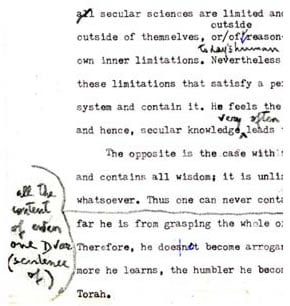 This essay is adapted from The Chabad Movement in the Twentieth Century, eds. Yitzhak Kraus and Moshe Hallamish (Ramat-Gan: Bar-Ilan University Press, 2005), with permission of the editors.
This essay is adapted from The Chabad Movement in the Twentieth Century, eds. Yitzhak Kraus and Moshe Hallamish (Ramat-Gan: Bar-Ilan University Press, 2005), with permission of the editors.
Let me begin with a story I heard from Robert Abrams, formerly the borough president of the Bronx and district attorney of the State of New York, and currently a practicing lawyer. As an influential New York politician, he had several private audiences with the Lubavitcher Rebbe, Rabbi Menachem Mendel Schneerson, who was often visited by such figures. On one of his visits to the Rebbe, Mr. Abrams was accompanied by his wife, Diane, who sat beside him in the Rebbe’s office while the two men discussed current political and economic issues. Diane Abrams is herself an accomplished lawyer, and by her own account “not a shy person at all.” Assuming, however, that the Rebbe was interested in conversing only with her husband, she sat silently as they spoke. After some time, the Rebbe turned to her and said with a smile: “Why aren’t you saying anything? These are the days of women’s liberation . . .”1
This little vignette summarizes the essence of what I want to say here, and my study of the Rebbe’s writings, talks and activities in relation to women—and my own personal contact with him. I think he discerned the deeper meaning of what was occurring historically in relation to women. The Rebbe saw within the stirrings of the women’s movement a deep spiritual inner dimension and strong redemptive energiesHe saw within the stirrings of the women’s movement a deep spiritual inner dimension and strong redemptive energies. He understood the need to use these energies for the good, and so encouraged women to speak, articulate their yearnings and achieve their spiritual aspirations. And he himself worked very practically to implement all of this—from a global level down to encouraging one woman sitting in his office to speak her mind.
While I have written other essays that examine in depth the Rebbe’s halachic and theological approaches to the status of women in Torah, this one will be somewhat different. It supplements those with a personal account from the point of view of an outsider/insider or participant/observer. There are many forms of knowledge, and there is a certain dimension of understanding one gains only through an insider’s position, and through having known one’s subject “face to face.”2 This is particularly true in relation to a “Rebbe,” a figure who functions on many levels—not just as a thinker, writer, teacher, rabbi or public leader, but also as an intimate, personal counselor. So I hope to add a personal perspective to the literature about the Lubavitcher Rebbe’s relation to women’s issues.
While it is quite clear to me that the Rebbe understood and sympathized deeply with the yearnings and aspirations of women on many levels, it is important to first portray briefly here the larger theological-metaphysical framework in which he perceived their strivings, and their place in his overall vision of Jewish history, the mission of the Jewish people and redemption.
The Rise of the Feminine Era in Kabbalah and Chassidism
Those familiar with chassidic philosophy recognize the idea that there are “sparks of holiness” (nitzotzot kedushah) scattered throughout our lowly physical world, awaiting their redemption through our actions. Concurrently, there is the chassidic-kabbalistic principle the Rebbe also often cited, that “everything that happens below has it source in what happens Above.” I think he took this principle also to mean that there was a specific historical-theological reason why the women’s movement was occurring in our times, and that our task was to infer what it signified for the current generation.
In an oft-quoted passage from a talk on Jewish education for women given in 1990, the Rebbe reinterprets the basic Talmudic and halachic sources regarding women’s Torah study, draws out the practical implications, exhorts women to increase their study and teaching, and asks for the community at large to support this endeavor. He further asks: why has this increase in Torah learning for women occurred specifically in the recent era? On the one hand, the Rebbe answers, there is the traditional idea that each generation further from the divine revelation at Sinai is on a “lower” level, and so there is an increasingly greater need to bolster it. The Rebbe described the increase in Torah study by women as one of the “positive innovations of the later generations”Nevertheless, he continues, the result has been a great good, an increase in Torah study; and this increase in Torah study by women he emphatically describes as one of the “positive innovations of the later generations.”3
From another perspective, each generation further away from Sinai is also closer to the final redemption and the messianic era. And so, the Rebbe adds, we could say we have merited the increase in Torah study for women precisely because of that proximity: it is part of the preparation for—and already a taste of—redemption. A defining characteristic of the messianic era is a great increase in knowledge and wisdom; and so we now already have a “taste” of it, just as there is a halachah (Torah law) that before Shabbat one is to taste each of the special dishes to be enjoyed at the Shabbat meal.4 (This also connects to the idea the Rebbe often repeated, that different parts of Torah are revealed in the times appropriate for them. Hence, he explained, only in recent generations has the esoteric “soul” of Torah—kabbalah and chassidism—been revealed and become increasingly accessible to the masses. Even though these latter generations might be on a lower level than previous ones, they also have a greater responsibility, for they are to purify and complete the final galut (exile) and open the way to redemption. Hence the most sublime parts and secrets of Torah are revealed in the latter generations, and they already begin to “taste” of the Torah of the messianic era.)
But there is an even deeper connection—continues the Rebbe in the above talk—of women to the messianic era. Kabbalistic and chassidic teachings have a special understanding of the role of the feminine in the era of redemption and the world to come. Then, say the classical sources, all the “feminine” aspects of the world will emerge from their concealment and diminution in the unredeemed world, and rise to the highest stature.5 That is the deeper reason—says the Rebbe—that in our generation the innovations and increase in Torah study connect to and are emphasized in relation to women. The effect of their study is also great, for as the Talmud says in a well-known line: “In the merit of the righteous women of that generation were the Jews redeemed from Egypt.”6 And so, the Rebbe concludes, in the merit of the righteous women of our generation, may the full and complete redemption come.
Many other chassidic leaders and thinkers, including his own predecessors in the Chabad movement, write of the time of the redemption in these kabbalistic terms as the elevation of the “feminine” side (malchut or nukva, as it is called in the literature). As far as I know, however, the Rebbe is the only one to specifically connect this long-held and abstract mystical idea to concrete sociological phenomena occurring in our time. He did not let it remain a metaphorical depiction of some coming future era far from us, unrelated to the current realities of women’s lives.7The Rebbe concludes that in the merit of the righteous women of our generation the full and complete redemption will come
This perspective paralleled his reinterpretation of the halachic obligations of women in the mitzvah of Torah study, and within Chabad, his encouragement of their dramatically increased public participation in Chabad outreach activities.8 He also transformed the role of the shluchah—the wife of the shaliach or Chabad “emissary.” The Rebbe sent thousands of young families to serve as his “emissaries” all over the globe to found Chabad houses and reach out to fellow Jews. He made the women’s role independent in its own right. He instituted the Kinus ha-Shluchot, an annual conference in the Chabad Center in New York for these women emissaries, just as the Chabad male shluchim had all gathered from all over the world once a year in Crown Heights. The women came to New York for a long weekend of workshops and lectures, and had special gatherings with the Rebbe in the main synagogue; the men sat upstairs, where the women usually sit for prayers, while the women sat with Rebbe downstairs.
My Personal Experience
My relationship with the Rebbe began when I was a graduate

student in English literature in the 1970s, and used part of a fellowship I had to research and study for six months in the Chabad world center in Brooklyn, New York—the place where the Rebbe had resided since coming to America in 1941. Over the years I developed strong ties to the community and to Chabad Chassidism, and had personal contact with the Rebbe in many ways: participating in his farbrengens (public gatherings), corresponding and consulting with him, intensively studying his writings, and brief face-to-face encounters. I had ample opportunity to observe him up close, and to experience personally his relation to women.
During my time in Crown Heights and afterwards, I wrote several essays about Chabad chassidism, many of which were based on research into the Rebbe’s writings, and several of which he edited personally. In 1978, while completing my Ph.D. work in literature, I also co-translated into English, with a Chabad rabbi, an important philosophical and hermeneutic discourse of the Rebbe’s on the nature of chassidic thought, entitled Inyanah shel Torat HaChassidut (English title, On the Essence of Chassidus9). The manuscript was given to the Rebbe to be checked prior to its being published in honor of his 75th birthday. My rabbinical co-translator told me with a smile that it was reported to him that when the Rebbe was shown the manuscript for his comments, he did not question my participation or credentials, but instead those of my male colleague, who was well-known as a highly learned Torah scholar: “Since when does Rabbi G. know English so well?” asked the Rebbe.
At the suggestion of one of his secretaries, Rabbi Binyomin Klein, I had also consulted with the Rebbe about my Ph.D. dissertation topic. I was not the only one, of course, to be writing to the Rebbe for advice. The secretary told me that the Rebbe received and answered about four hundred letters a day. This was in addition to the endless phone calls and faxes that deluged his office in the course of any 24-hour period, along with the personal audiences he had with his followers and the many different people who came from all over the world to see him, and which lasted late into the night. I had at that time thought of two possible dissertation topics: one on Shakespeare, and one on literary theory and rabbinic methods of interpretation. I often like to ask people which topic they thought the Rebbe advised me to write about. Many answer, “Shakespeare.” I had two possible dissertation topics: Shakespeare or literary theory and rabbinic methods of interpretationWhen asked why, they surmise he would not like me to mix rabbinic and secular studies, or would not think that as a woman I had enough knowledge to pursue that topic. Those who choose the rabbinics option say they think he would want me to try to bring Yiddishkeit into the university, as part of the well-known Chabad emphasis on outreach. The answer was neither. The Rebbe’s advice, as conveyed to me in the note typed by Rabbi Klein reproduced below, was as follows:

My translation into English: “It depends on what could be surmised about the attitude toward religion and Judaism of those who will be examining her Ph.D. work (that they should not be anti-religious, for then there would be some apprehension that they would disturb her and be opposed, and so forth).”
(Parentheses in the original; the Rebbe’s answer was also phrased in the third person, in the formal European style of polite respect.)
This response, I would say, was characteristic of the Rebbe. For as much as he was deeply immersed in the mystical traditions of chassidism and kabbalah, as much as he was forcefully engaged in a wide variety of campaigns to spread Yiddishkeit to every corner of the world, as idealistic he was about the “pure spark” in the soul of every Jew and about the ever-present potential of redemption, he was also very grounded, and pragmatic down to the last detail. The answer reflects an astute awareness of the politics of the university and of academic committees. It was very astute advice, which I followed, and which I now also give to my own graduate students: choose your academic advisor and dissertation committees very carefully. In the end I chose to pursue the topic of rabbinic interpretation and its relation to modern literary theory, which eventually became my first book, The Slayers of Moses: The Emergence of Rabbinic Interpretation in Modern Literary Theory.
The Rebbe Edits My Work
There were other very concrete and pragmatic ways in which the Rebbe assisted me in my writing and encouraged my academic work. One was connected to his active and intense interest in the activities of the Chabad women’s organization, N’shei Chabad. One of the organs of this organization was a journal called Di Yiddishe Heim, “The Jewish Home.” It is a small bilingual “in-house” magazine, half the articles written in Yiddish and half in English, and directed towards a lay audience of women of the Chabad community. When I came to study in Crown Heights in 1977 while a graduate student in English Literature, the feminist movement was in full swing. As a graduate of an Ivy League women’s college at the forefront of the movement (Smith College, where my commencement address was given by Gloria Steinem), I was troubled by the issues feminism raised about the role of women in Judaism. As I learned more Chabad philosophy, I found very interesting talks and writings of the Rebbe and sources from previous rebbes which discussed the role of the “feminine.” In order to help myself deal with these questions, I wrote an article based on these sources for Di Yiddishe Heim entitled, “The Jewish Woman: Three Steps Behind?”
Articles for the journal were written by both men and women, and the editor was a woman. I wrote the article and handed it in to her, and she accepted it for publication. A short while afterwards, long before the article actually appeared in print, I wrote my first personal letter to the Rebbe to consult with him about something. After answering the personal issue, he added the following words:
Translation: “I enjoyed her article in the forthcoming ‘Yiddishe Heim,’ and may G‑d grant her success in all her other activities.”
I was surprised, and did not know how the Rebbe would have known about the essay before it was published. So I asked the editor, who told me that although few people knew about it, after she had edited all the manuscripts, the Rebbe went over them again, editing them himself. And he took this time due to his great interest in the activities of women and his desire to support and encourage them. I subsequently wrote several articles for this journal, many based on ideas from his published public talks and discourses; and, as a favor to me and encouragement to write more, the editor gave my original manuscripts back to me with the Rebbe’s corrections.
In these corrections, one sees him relating with great care to the efforts of a young academic woman beginning to learn chassidic teaching and trying to relate it to current issues in philosophy, literature and politics. The extraordinary pains he took to read and edit my writing in English—including its typos, punctuation and grammar, as well as phraseology and ideas—astounded me and reminded me of the kind of the detailed, fatiguing reading and commenting I did for my own students when I taught intensive courses in English Composition. What follows are some representative examples from these manuscripts.
“One Sentence of Torah”
One essay I wrote was on “The Search for Truth—‘Religion’ and ‘Secularism,’” discussing the relationships among secular knowledge, Torah and science—an issue with which I was concerned at the time. In the article, I wrote the following paragraph:
Click on image to see a facsimile of this paragraph with the Rebbe’s handwritten revisions in pencil
Scientists, for example, have had to deal with the “uncertainty principle” and the recognition that at a certain level of observation, the observer so interferes with his data that he can’t attain any certain conclusions. Philosophers no longer attempt to explain the whys and hows of the universe, and restrict themselves mostly to analyzying language and logic—refusing to deal with “metaphysical” questions. Modern literature is extremely bleak, describing in painful detail the emptiness of the mind turning on itself, disconnected from the heart, and incapable of action. [Note: I must add here that this was written before the use of gender-inclusive language became prevalent, so all the pronouns refer only to “he.”]
The Rebbe edited this paragraph by
- deleting the extra words “so interferes with his data that he”
- changing “any certain conclusions” to “a certain conclusion”
- adding apostrophes to the phrase “why’s and how’s”
- correcting my typo in the word “analyzying” to “analyzing”
- changing the phrase “language and logic” to “events, phenomena etc.”
In this essay, as well as others I wrote in an earlier time of more youthful extremism, he also qualified my large generalizations—as I often find myself now doing with the writing of my own students. Further on in the essay, I referred to a sichah (“talk”) he gave about this subject10 and I wrote:
Click on image above to see this paragraph, as well as the following paragraph described below, in the original manuscript with the Rebbe’s revisions
. . . all secular sciences are limited and imperfect. They do not posses anything outside of themselves, or outside of reason—and furthermore, reason itself has its own inner limitations. Nevertheless, the Rebbe points out, it is precisely these limitations that satisfy a person, because he can grasp the entire system and contain it. He feels the satisfaction of mastering a body of knowledge, and hence, secular knowledge leads to arrogance.
In this paragraph, the Rebbe
- deleted the word “all” in the first line, so it then read instead “secular sciences are limited and imperfect”
- inserted the words “today’s human” to the next line, which now read “or outside today’s human reason”
- qualified my sweeping generalization in the last line by inserting the adverb “very often” to the phrase “secular knowledge leads to arrogance,” to now read “secular knowledge very often leads to arrogance”
The essay continued with my writing in the next paragraph that the opposite was the case with the study of Torah, which is an unlimited, infinite wisdom:
Thus one can never contain Torah, master it. A person always feels how far he is from grasping the whole of it and fathoming its infinite depth. Therefore, he doesn’t become arrogant, but on the contrary—humble. And the more he learns, the humbler he becomes, and the greater is his thirst for learning Torah.
The Rebbe here, in what is my most favorite revision of his, inserted the words “all the content of even one Dvar (sentence of)” in the first line. The Rebbe relates with great care to the efforts of a young academic woman beginning to learn chassidic teaching and trying to relate it to current issues in philosophy, literature and politicsIt then read: “Thus one can never contain all the content of even one Dvar (sentence of) Torah, master it.” Yet he was indeed one of the masters of Torah in our generation. I remember attending his farbrengens—public gatherings the Rebbe would hold. The large synagogue in Brooklyn would be packed with a thousand or more people. If it were a weekday, he would start to speak at around 9:30 PM, and often give several sichot or “talks,” each lasting about forty minutes. Without a note, he would speak into the early hours of the morning, for five or more hours, citing liberally from memory and constructing innovative interpretations intricately woven from of the whole corpus of Jewish literature—Bible, midrash, Talmud, the classic commentaries, kabbalah, Jewish law, chassidic philosophy.
There are also the many personal stories of scientists and mathematicians who corresponded with and spoke to the Rebbe about the technicalities of their work, and which he corrected as well. In the essay I wrote on Torah and science, I went on to paraphrase a well-known talk of his given on Parshat Noach 5738,11 in which he speaks of the pre-eminent truth of Torah that “G‑d is One” as also meaning the following:
Unity is more true than diversity; the real truth is the interdependence of all things into a unity, the Unity of G‑d. The multiplicity of creation is no contradiction to the Unity of G‑d; indeed this multiplicity comes from His Unity, as Chassidut explains at length.
The Rebbe has pointed out that science is approaching the same realization, so to speak. He explains that it was once thought that every natural force was an independent power, that the substance of every being was composed of many different elements. With the growth and progress of science, however, man is coming more and more to realize that this multiplicity and separation of elements is something external—merely the manner in which parts combine, the way they are broken down or expanded. Science has more and more reduced the number of essential elements until it has come to the realization that the essence of the existence of the world consists in the unification of two aspects: “quality and quantity,” or “energy and mass”; everything is a unity of these two aspects. What science does not yet realize or admit is that this unity is from G‑d and is an aspect of His unity.
Click on image to see the full paragraph
His corrections to this paragraph were:
- to change the phrase “composed of many different elements” to “composed of essentially different elements”
- to delete the word “external” from the phrase “this multiplicity and separation of elements is something external”
- to insert the phrase “has made it its goal to” to the beginning of the sentence, “Science has more and more reduced the number of . . .”
- to invert the word order of “more and more reduced” to “reduced more and more”
- to change the phrase “essential elements until” to “basic elements and forces until”
- to change the phrase “the unification of two aspects : ‘quality and quantity’” to “the two ultimate aspects: quality and quantity”
- to qualify my sweeping generalization, “What science does not yet realize” to “What some scientists do not yet realize”
Women’s Unique Powers of Eliciting Holiness
There was a case, however, in which the Rebbe intensified a large generalization I had made, one specifically about Jewish women.
In another essay I wrote, entitled “Judaism and Feminism: Our G‑d and the G‑d of Our Mothers,” I explicated some of his writings on the nature of feminine spiritual power in the light of chassidism and kabbalah. The focus, in particular, was on the relation of the two sefirot (the divine attributes in kabbalistic thought, which also are the superstructure of the world) chochmah and binah, “wisdom” and “understanding.” These are also called “Father” and “Mother,” and he discussed their relation to the “Fathers” and “Mothers,” i.e., the patriarchs and matriarchs of Israel, and the powers they bequeathed to the Jewish people. To summarize briefly: in commenting on the Parshah (Torah reading) of Chayei Sarah (Genesis 23:1–25:18),12 the Rebbe discussed the quality of binah, and the ability of the feminine “attributes” to more closely affect the physical world and bring what is actual out of what is potential—both in the kabbalistic schema, and on the parallel psychological-physical plane of our mundane world of male and female.
In the essay, I prefaced the idea by explaining a foundational notion in chassidic thought, and wrote that before the giving of the Torah at Mount Sinai, the physical and spiritual “realms had been separated from each other and not connected.” To this sentence, the Rebbe inserted the adverb “perfectly”—“had not been perfectly connected.” The Rebbe discussed the quality of binah to bring what is actual out of what is potentialHe had further elaborated the idea in the sichah that the mitzvot performed by the patriarchs and matriarchs, who lived in the pre-Sinaitic era, helped prepare the way for the stronger, more perfect connection that would occur later, but their mitzvot could not affect the physical world as strongly as those we perform after the giving of the Torah.
Here he had made a very interesting distinction between the kinds of kedushah, “holiness,” the patriarchs and the matriarchs respectively brought into the world. The matriarchs of Israel brought a different kind of kedushah into the world than did the patriarchs, he maintained. The patriarchs could draw into the world a “holiness” that would remain in the physical object after the mitzvah they performed was fulfilled—but only in that part of the physical which had a connection to the patriarchs themselves. For example, the mitzvah of circumcision which Abraham was commanded drew kedushah into the body that fulfilled the mitzvah, but not into the world outside. However, through Sarah, the first matriarch, kedushah was drawn into a part of the world outside of her, and this power she bequeathed to all Jewish women. (For a further analysis of how and why this is so, see the original sichah).
In another sichah,13 the Rebbe wrote of another distinctive trait Jewish women possess more than men, which is indicated by G‑d’s giving of Rosh Chodesh (the first day or days of the Jewish month) as a special holiday to Jewish women in all generations and into the world to come as a reward for their not participating in the sin of the golden calf. The Rebbe describes this special female attribute as a certain unshakable attachment to and deep faith in G‑d that helped the Jewish women in the desert resist the trials to which the Jewish men succumbed. Although this feeling of pure faith is rooted in the heart of every Jew, male and female, he adds, it can become covered over or concealed due to various difficulties, and its effect on daily life and behavior no longer be visible. Jewish women, he asserts, have however a special strength in not permitting concealment of this feeling and its effects on behavior. As I summed up these ideas in my essay, I wrote:
The Rebbe points out that the reason why this great reward is given to all Jewish women in all times, till the coming of the Messiah and after (and not just to the women of that one generation [who left Egypt and contended with the golden calf]) is because the power to withstand such a great test which even the men could not endure comes from an innate superior trait that all Jewish women in all ages possess.
In the original version, I myself had twice underlined the word “all” in the first line, but not in the last part of the sentence where this adjective is used again. Here, however, the Rebbe intensified my generalization by underlining once again the last two uses of the word “all”: “all Jewish women in all ages.” And then once more again later on in the essay, where I summed up and wrote, “Every Jewish woman, in every time and every place, has inherited the special powers of the matriarchs,” he underlined the first word, “Every.”
“There Must Also Be A Girl In The Picture”
Around 1980, the Rebbe initiated a campaign to encourage children to take more part in the overall public activities and initiatives of Chabad, and become part of Tzivos Hashem, “The Troops of G‑d.” Many pamphlets were produced for this campaign, and the chassidim who were in charge of it founded a journal for children called The Moshiach Times. Several highly interesting editorial comments and corrections to this magazine were also made by the Rebbe. One of the later staffers of the journal, Dr. David Sholom Pape, compiled a series of these.14 He relates that on the cover of the very first issue there was a drawing of two rows of children—one of boys and above it another of girls, each child carrying a banner with a letter on it, which all together spelled the words ahavat Yisrael, “Love of a fellow Jew” (figure 1).
 One of the older chassidim on the staff balked, and wondered if it was “modest and chassidish for boys and girls to be on the same cover.” The younger members of the staff argued that since it was a magazine for both boys and girls, it was indeed appropriate. To resolve the dispute, the cover was sent to the Rebbe for his instructions on the matter. The Rebbe, however, did not instruct the staff to remove the girls from the cover.
One of the older chassidim on the staff balked, and wondered if it was “modest and chassidish for boys and girls to be on the same cover.” The younger members of the staff argued that since it was a magazine for both boys and girls, it was indeed appropriate. To resolve the dispute, the cover was sent to the Rebbe for his instructions on the matter. The Rebbe, however, did not instruct the staff to remove the girls from the cover.
The matter arose again when the second issue was prepared for Purim, and the cover had a boy and girl in Purim costumes, dressed as Mordechai and Esther blowing bubbles in which were images of the mitzvot of Purim (figure 2). Again, objections were raised that such an image of a boy and girl playing together in proximity was against chassidic ethics; the previous cover had had the boys and girls separated in rows, but now the boy and girl were next to each other! The cover was again sent to the Rebbe, who simply returned it with a check indicating it was fine to print.
 The third issue was designed for Passover and had a cover sketch of a boy looking into a stamp album, each stamp depicting one of the fifteen steps of the Passover Seder. The angle of the drawing and the size of boy’s head and the album left no room for an image of a girl as well. Since the other two covers had been sent in, this cover was also sent to the Rebbe for approval, and the answer came back:
The third issue was designed for Passover and had a cover sketch of a boy looking into a stamp album, each stamp depicting one of the fifteen steps of the Passover Seder. The angle of the drawing and the size of boy’s head and the album left no room for an image of a girl as well. Since the other two covers had been sent in, this cover was also sent to the Rebbe for approval, and the answer came back:
Tzarich lihyot gam na’arah—“There also needs to be a girl.”
The artist redrew and redesigned the cover to add the head of a girl on the left side and the boy on the right side (figure 3), and by then a custom had been established to send the covers in to the Rebbe for all the issues.
A few years afterwards, in 1984, a cover was prepared by a well-known cartoonist for the Elul issue, portraying a boy returning home from summer camp to his room, carrying his sports equipment. The room is portrayed as filled with holy objects, equipment for a solider in Tzivos Hashem—a chumash, siddur, charity box, and so forth, and he is wearing a kippah and tzitzit. The cover was sent in to the Rebbe, who returned it with two comments: “The tzitzit should be seen” and “There must also be a girl in another corner.”
I conclude with these stories since I think this directive, “There must also be a girl in the picture,” summarizes what I have been saying throughout. On the broadest theological-metaphysical level, the emergence of the aspect of the “feminine,” of malchut, was also the deepest question of redemption. And the Rebbe connected the most abstract speculations and concepts in kabbalah and chassidism to the most practical and detailed endeavors in daily life.
I think this stance was also related to how he saw himself in the role of the seventh Lubavitcher rebbe. His mission was to continue and expand all the work of the previous rebbes, but especially that of his father-in-law, the sixth Lubavitcher rebbe, Rabbi Yosef Yitzchak Schneersohn—to widely diffuse, develop and bring the latter’s work completely into concrete reality. There is a Chabad chassidic idea that each of the seven rebbes paralleled a different sefirah. In this schema, the sixth rebbe, Rabbi Yosef Yitzchak, paralleled the sefirah of yesod, and Rabbi Menachem Mendel, the seventh, was malchut—the last sefirah in the kabbalistic schema, which is on the “feminine” side of the sefirot. Malchut, the last sefirah, receives and channels all flow from the preceding configurations of sefirot, and connects and implements them in the physical world. It is also called “sovereignty” or “kingship,” as defined by the notion of a king whose power comes only by virtue of the people, and whose life is given over to serve the people and to implement physical action in the world.
The Rebbe would often vigorously end his public discourses with the words “u-lematah me-asarah tefachim, b’karov mamash!” (“Below ten handbreadths, soon and really!”) In other words, to bring all the wishes for good for the Jewish people, for redemption, for tikkun of the world—to bring this all down from abstract concepts and spiritual ideas to “below ten handbreadths.” “Ten handbreadths” is the halachic measurement for a “private domain” on Shabbat, but more to the point, a reference to the rabbinic saying that “the Shechinah (divine presence) never descended below ten handbreadths.”15 In other words, to bring this all completely down to earth, to the ground, to our collective and individual literal, historical, physical, daily, mundane existence. And this, too, I believe, is what he tried to do in putting women “into the picture” of Jewish life, not just in theory, but pragmatically and actually—“soon and really”!
FOOTNOTES
1.See the video interview with Diane Abrams in which she relates this anecdote.
2.I have written in depth about this question in my essays, “‘Knowledge Has a Face’: the Jewish, the Personal, and the Pedagogical” in Personal Effects: The Social Character of Scholarly Writing, eds. David Bleich and Deborah Holdstein (Utah State University Press, 2002), pp. 121–144, and “‘Stopping the Heart’: The Spiritual Search of Students and the Challenge to a Professor in an Undergraduate Literature Class" in Religion, Scholarship and Higher Education: Perspectives, Models and Future Prospects, ed. Andrea Sterk (Notre Dame University Press, 2002), pp. 202–230.
3.“Al Devar Chiyuv Neshei Yisrael be-Chinuch uve-Limmud ha-Torah 5750 [1990]” in Sefer ha-Sichot, vol. 2 (Brooklyn, N.Y.: Kehot, 1992), pp. 455–459.
4.See the Rebbe’s discourse on the nature of chassidic philosophy and its innovations entitled Inyanah Shel Torat ha-Chassidut (and the appendix printed there, a discourse given on the last day of Passover 1970) on the timing of revealing new insights and aspects of Torah. It is translated into English in the volume On the Essence of Chassidus (Brooklyn, N.Y.: Kehot, 1978).
5.That is the deeper meaning of the famous verse from Proverbs (12:4), “A woman of valor is the crown of her husband,” and from the prophet Jeremiah (31:21), “The woman will encircle the man.” The crown, symbolizing the highest kabbalistic sefirah (divine attribute) of Keter, sits on top of and encircles the head. Similarly, in the prophecy of Jeremiah, “the woman encircling the man” signifies the highest level of divine revelation, in the mode of a “circle” (makkif). In a circle, all points are equidistant from the center, as opposed to the hierarchical structure of a line. A circle also symbolizes what encompasses and can’t be contained and delimited. There are hints to this in the wedding ceremony, where the bride indeed encircles the groom, and in the language of the wedding blessings. See further the chassidic discourse of R. Schneur Zalman of Liadi in his Torah Ohr, end of Parshat Vayigash, and his commentary on the siddur and the wedding blessings for the relation of male and female in the messianic era and the world to come.
6.Sotah 11b.
7.Naftali Loewenthal adds, however, that “at the same time, one cannot quite leave out what R. Yosef Yitzchak [the Rebbe’s father-in-law and predecessor] was doing. His presentation (in his Zichronot) of women secretly studying Talmud in the ancestry of R. Schneur Zalman, his setting up of Achos ha-Temimim [a women’s study group] in Riga in the 1930s, and his statements about this, are very interesting in terms of a new view of womanhood. The messianic aspect is not stated, but then in general his intense messianism (seen in Ha-Keriah veha-Kedushah) is not expressed in his discourses and other teachings.” Personal e‑mail correspondence with the author, August 19, 2002.
8.See my essay “Women and the Study of Torah in the Thought of the Lubavitcher Rebbe” in Jewish Legal Writings by Women, eds. Micah D. Halpern and Chana Safrai (Jerusalem: Urim Press, 1998), pp. 143–178, for an explication of his technical halachic analysis of the mitzvah of Torah study for women. This analysis was printed in the Rebbe’s Likkutei Sichot, vol. 14 (Brooklyn, N.Y.: Kehot, 1978), pp. 37–44, and reprinted in Chiddushim u-Veurim le-Shas, vol. 1 (Brooklyn, N.Y.: Kehot, 1979), pp. 217–223. The Rebbe concludes, through a careful analysis of the classical sources and Shulchan Aruch ha-Rav, that the mitzvah of Torah study for women is based not only on the need she has to know the laws pertaining to her—the classic justification—but acquires its own independent status as talmud Torah for its own sake (li-shemah).
On a sociological level there were also many mivtzoim, public campaigns initiated by the Rebbe, that involved dramatically increased public participation of women in both their performance and their promulgation. Among these were the campaign to have all girls from the age of three and upwards light Shabbat candles, and to spread and publicize in as many forums as possible public knowledge of the mitzvah of taharat ha-mishpachah, the laws of family purity.
9.See note 4.
10.Likkutei Sichot, vol. 4 (Brooklyn, N.Y.: Kehot, 1964), p. 1101.
11.Likkutei Sichot, vol. 15 (Brooklyn: Kehot, 1980), pp. 42–48.
12.Likkutei Sichot, vol. 5 (Brooklyn: Kehot, 1972), pp. 336–353.
13.Likkutei Sichot, vol. 8 (Brooklyn: Kehot, 1974), pp. 317–319.
14.Dr. Pape printed them in the Souvenir Journal: Celebrating the Wedding of Bentzion and Rochie Pape, 30 Adar I, 5760—a private illustrated gift volume distributed at the wedding of his son. I am grateful to R. Shlomo Gestetner of the Mayanot Institute in Jerusalem for locating this source for me.
15.Talmud, Sukkah 5a.
LIFESTYLES
 Macerated Strawberry Ice Cream
Macerated Strawberry Ice Cream
Have you ever had fresh strawberry ice cream?
By Miriam Szokovski
Have you ever had fresh strawberry ice cream? It's nothing like the sickly sweet stuff you can buy. It makes you suddenly realize, "Ohhh, this is the flavor store-bought strawberry ice cream is trying to imitate!"
I whipped this up a couple of weeks ago for a friend who was one week post partum and her family. It was an instant success with both the adults and children. I've tried it out on a few other friends since then and it's been pretty much unanimous. The taste is fresh and sweet - but not overly so - with a tart undertone from the fresh berries.
Did I mention? It's also super simple, with only 5 ingredients: strawberries, sugar, heavy cream, vanilla and salt.
Wash and hull the strawberries. Cut then in half (or quarters if they're particularly big. Sprinkle half the sugar over the strawberries and let them sit for 15 minutes. Stir and let sit another 15 minutes or so. The sugar will macerate the berries, making them release their juices and become all syrupy.
Pour the strawberries (and the syrupy juice) into a blender. Add the rest of the ingredients and blend until smooth. Don't over-mix.
Pour the mixture into the bowl of an ice cream machine and churn until thick and creamy. Serve immediately or freeze for later use.
Two suggestions if you don't have an ice cream machine:
Pour the blended mixture into ice pop molds. They'll be a cross between ice cream and ices.
Blend the macerated strawberries. Set aside. Whip the heavy cream until soft peaks fall. Sprinkle in the remaining sugar, and the vanilla and salt and mix until just incorporated. Using a spatula, gently fold in strawberry mixture. Freeze for a couple of hours. Remove, mix and refreeze.
The other question I'm anticipating is how to make this non-dairy. Unfortunately I haven't come up with a good method yet. Coconut milk overpowers the strawberry taste, and non-dairy whip just tastes so chemically. So for now I recommend going dairy. True, you can't eat it after a meat meal, but it's summer - have fun, go a little wild, make dairy ice cream - you won't regret it!
Ingredients:
1 lb strawberries, washed, hulled and cut
1/2 cup sugar, divided
2 cups heavy cream
1/4 tsp. salt
Seeds of 1 vanilla bean or 2 tsp. vanilla extract
Directions:
Wash, hull and halve the strawberries.
Sprinkle 1/4 cup sugar over the strawberries and let them sit for 15 minutes. Stir and let sit another 15-20 minutes. The berries will become syrupy.
Blend the strawberries (and the syrup they emitted) with the heavy cream, rest of the sugar, vanilla and salt.
Pour the mixture into the bowl of your ice cream machine and churn until thick and creamy. Serve immediately or freeze for later.
So... spill the beans. What's your favorite kind of ice cream?
________________________________________
More in Lifestyles:
• Windows in Jerusalem (By Yehudis Khanin)
Chalks, Charcoal, Aquarelle, Ink
Artist’s Statement: I paint city scenes mostly. When I am in the process, I visualize how I want the picture to look, no matter if I need to use medium in an unusual manner to accomplish that. I am a very visual person and have a strong need to express myself through art.
JEWISH NEWS
 Events Large and Small Honor the 20th Anniversary of the Rebbe’s Passing
Events Large and Small Honor the 20th Anniversary of the Rebbe’s Passing
With the approach of the third day of the Jewish month of Tammuz—this year commemorated on Tuesday, July 1—Jewish circles everywhere are marking its significance in ways large and small.
By Karen Schwartz
 |
| An estimated 10,000 people, including children, gathered in the Yad Eliyahu Stadium for a Gimmel Tammuz program. (Photo: Meir Alfasi) |
With the approach of the 20th anniversary of the passing of the Rebbe, Rabbi Menachem M. Schneerson, of righteous memory, on the third day of the Jewish month of Tammuz—this year commemorated on Tuesday, July 1—Jewish circles everywhere are marking its significance in ways large and small.
Large can be construed as the event that just took place Friday in Tel Aviv, where an estimated 10,000 people, including children, gathered in the Yad Eliyahu Stadium for a Gimmel Tammuz program in an Israeli city not known for its religious observance. Still, the Mediterranean metropolis stopped to pay tribute to one of the great Jewish leaders of the 20th century, who propelled Chabad well into the 21st.
Thousands of visitors from around the world are arriving in New York to commemorate the yahrtzeit (anniversary of passing) at the Ohel, the resting place of the Rebbe, in Queens, N.Y.
Many are expected to attend an all-encompassing symposium on Sunday, June 29, titled “Soul Encounters,” which will take place at the Kupferberg Center for the Arts at Queens College in New York City. Five individual sessions, musical interludes and videos, and a final plenary talk will incorporate rabbis, educators and speakers across the board, including Chief Ashkenazic Rabbi of Israel David Lau, who with Sephardic Chief Rabbi of Israel Yitzchak Yosef has publicly called for worldwide commemoration of Gimmel Tammuz with increased mitzvah observance. Other principal representatives include Rabbi Yehuda Krinsky, chairman of Merkos L’Inyonei Chinuch, the educational arm of Chabad-Lubavitch; and Rabbi Moshe Kotlarsky, its vice chairman. Information and registration are available on the event’s web site, www.soulencounters.org.
And as part of the program, Chabad emissary Chaya Teldon plans to discuss a subject affecting all Chabad families: being “A Mother in the Rebbe’s Army.”
Online Opportunities and Information
For those commemorating the Rebbe’s yahrtzeit online, and for more information about the day, readers can consult "What To Do On 3 Tammuz: Six simple suggestions for the Anniversary of the Rebbe" and its counterpart "The Insiders Guide to the Third of Tammuz" on the newly redesigned TheRebbe.org. These guides offer a quick six-step instruction manual and a more detailed program for Gimmel Tammuz, respectively, including the opportunity to send in prayer petitions that will be placed at the Ohel, as is customary.
An event in Boston featured Rabbi Shlomo Riskin.
Chabad.org writer and editor Rabbi Tzvi Freeman will teaching a live class “The Truth Doesn’t Die: Jacob, Moses and Eternal Life” on Tuesday at 8 p.m. on Chabad.org. Presented in cooperation with JNET, the Jewish Learning Network, viewers can submit questions and comments using a live chat option.
There is also a wealth of new content available on the redesigned TheRebbe.org, including the first section of an upcoming monograph, The Lubavitcher Rebbe’s Philosophy of Torah by Chabad.org editor Rabbi Yanki Tauber; Scholar, Visionary and Leader: A Chronological Overview of the Rebbe’s Life and Ideas by Chabad.org research writer and editor Rabbi Eli Rubin; and "Unconventional Wisdom," an infographic sampling of the Rebbe’s teachings and leadership.
A series of three “farbrengens” in honor of Gimmel Tammuz that were webcast last week on Jewish.tv include“ How to Bring the Rebbe’s Message into Our Daily Lives” with Rabbi Mendel Lipskier; “Marching Orders from the Rebbe for Each of Us” with Mrs. Mashi Lipskar; and “The Challenge of Our Times” with Rabbi Manis Friedman.
Women emissaries will also be connecting on June 29 at 5 p.m. (New York time) for a virtual farbrengen. The event features a packed program that includes talks from emissaries in Brooklyn, N.Y.; Los Angeles, Calif.; Johannesburg, South Africa; Shanghai, China; and beyond. It is being coordinated by shlucha Yehudis Bluming of the Rohr Chabad of Durham/Chapel Hill and Duke University in North Carolina; Goldie Plotkin of Chabad Lubavitch of Markham in Toronto, Canada; Channa Hecht of Chabad of Brentwood in Los Angeles, Calif.; and Leah Namdar of Chabad Lubavitch Sweden.
On the evening of July 1, a farbrengen for women is scheduled to take place in the Crown Heights neighborhood of Brooklyn, N.Y., with Rivkah Slonim, education director at the Chabad Center for Jewish Student Life at Binghamton University in upstate New York.
‘Intriguing Truths’
Not too far away in the New England area, Rabbi Alter Bukiet, co-director of Beit Chaim Meir Chabad Center of Lexington, Mass., joined with 25 Chabad centers in the Greater Boston area for a June 25 program at the Taj Boston luxury hotel in Boston.
Preparations were underway last week for visitors from around the world who will commemorate the yahrtzeit at the Ohel, the Rebbe's resting place in Queens, N.Y. (Photo: Chaim Perl)
Like Chabad Houses in the United States, Canada and around the world, he was participating in a commemorative event—one of many globally—celebrating the life and leadership of the Rebbe. Rabbi Shlomo Riskin, founding rabbi of Lincoln Square Synagogue in Manhattan and now chief rabbi of Efrat, was keynote speaker for “An Evening of Inspiration Commemorating Gimmel Tammuz.” Hundreds gathered to hear his personal story of the Rebbe, and how the Rebbe guided him in his earlier years establishing Lincoln Square and then fortified his move to Efrat.
“It’s one of the most intriguing truths that has developed in the Jewish world, to watch how the Rebbe’s influence is just growing,” says Bukiet. “The appreciation of what the Rebbe stood for hasn’t diminished—it’s taken on an unbelievable life.”
Riskin’s talk was preceded by an hour-long reception for the lay leaders sponsoring the event. Participants also watched a new video from Jewish Educational Media (JEM) about the Rebbe.
His vision is more than alive, stresses Bukiet, citing how his message and approach to Judaism are flourishing: “Major Jewish personalities standing up and speaking to that ends up influencing people to how real the Rebbe’s message is.”
In New York, Manhattan’s Park East Synagogue joined with Chabad on June 25 for a commemoration event including a film, songs and a string quartet. A cocktail hour and hors d’oeuvres was followed by stories of personal encounters with the Rebbe, songs and a keynote speech by Rabbi Yosef Yitzchak Jacobson.
Keeping the Momentum
Also in New York, Rabbi Pesach Burston, co-director of the Chabad of Orange County in Chester, N.Y., made a very important drive on Thursday night. He and a group of some 25 community members spent nearly an hour on the road each way to take part in a June 26 mega-event with other area Chabad centers.
They heard from Rabbi Yehuda Krinsky, who served as personal secretary to the Rebbe, at the Doubletree Tarrytown in Tarrytown, N.Y., during an evening dubbed “The Rebbe Up Close and Personal.”
“I believe the Rebbe is a big part of our Chabad House,” says Burston, explaining that everybody—from adults who come to study and children participating in Hebrew school or summer camp to those who stop in for the occasional service or a Kiddish lunch—is being touched by the Rebbe’s reach.
Indeed, though not headlined as part of social media or even generic email, informal programs at Chabad centers everywhere include children, who are also considered emissaries of the Rebbe and who represent the future of the movement. They celebrate in age-appropriate ways, with the encouragement ofmitzvot and acts of kindness a given.
Burston’s Chabad center is also holding a tribute event on Tuesday evening at 7:30 p.m., which is expected to draw some 50 people, and will feature a light dinner and a special presentation. “I’ll be talking about my personal connection with the Rebbe and the influence the Rebbe has on the community, even if they haven’t met the Rebbe,” explains Burston. “His teachings influence the way we learn, and the mere fact that we get together is because of the Rebbe. How could we not celebrate that?”
The rabbi, who was 16 at the time of the Rebbe’s passing, emphasizes that it’s significant and important to mark the day.
“The mere fact that 20 years after Gimmel Tammuz we’re so enthusiastic about the Rebbe … it’s just keeping the momentum going—the momentum that’s been going for the past 20 years.”
________________________________________
More in Jewish News:
• Worldwide Focus on Plight of Missing Boys in Israel (By Karen Schwartz)
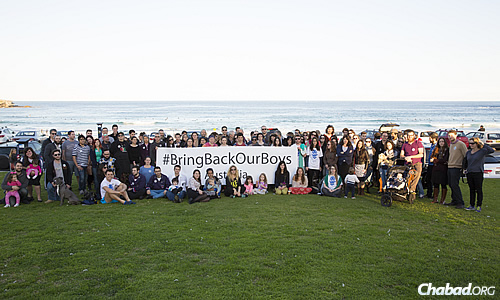 |
| More than 250 people showed up June 22 on Australia's Bondi Beach to show their support and relay their message: "Bring Back Our Boys." |
With the search for the three yeshivah students kidnapped in Israel becoming increasingly desperate, people around the world have been intensifying their prayers and acts of kindness. As the third Shabbat approaches—three weeks after the boys were taken—there are renewed calls for women and girls around the world to light Shabbat candles, and for all to pray on the students’ behalf.
This week and last were replete with planned and impromptu programs, rallies, prayer sessions and other campaigns to bring international attention to the dire situation of Gilad Shaar, 16; Naftali Frenkel, 16; and Eyal Yifrach, 19, who were last seen near Hebron on June 12. The Israel Defense Force has scoured the city and its environs as part of “Operation Brother’s Keeper,” and according to news reports, will decide where to shift its focus as the effort continues into its third week as suspects in the kidnapping have been identified.
Rabbi Yossi Lipsker, co-director of Chabad Lubavitch of the North Shore in Swampscott, Mass., went online last Thursday to vehemently send email, post to Facebook and Tweet alongside others to help spread the word about a candlelight vigil taking place that same evening, June 19, at 8 p.m. at the Chabad Community Shul. The focus was on the three missing boys.
The vigil drew about 50 people, somber and steadfast in the task at hand.
“My message was that these children are all of our children as well,” said the rabbi. “Something was taken from all of us; we are all being held hostage.”
The event was just one of numerous efforts taking place around the world to help raise awareness of the situation, and to pull communities together in prayer and mitzvot. The effort has become global in scale, with programs large and small worldwide.
“The coming together fostered a renewed collective hopefulness,” acknowledged Lipsker.
Chabad Lubavitch of the North Shore in Swampscott, Mass., co-directed by Rabbi Yossi and Layah Lipsker
Chabad.org has set up a special web page where readers can “pledge a mitzvah” on their behalf, and individual Chabad centers have been spreading the word on a local level.(Readers can continue to “pledge a mitzvah” on the students’ behalf here).
As Shabbat approaches, women and girls are urged to light candles, and all are asked to recite prayers for the missing boys, keeping in mind their Hebrew names: Yaakov Naftali ben Rachel Devorah, Gilad Michael ben Bat Galim and Eyal ben Iris Teshura.(For Shabbat candle-lighting times in your location, please click here.
People Coming Out of the Woodwork’
The U.S. East Coast has been awash in action, especially in the New York metropolitan area.
Israeli Consul General Ido Aharoni attended a massive rally on June 18 in New York City with supporters that included city officials and legislators, community leaders, Holocaust survivors, survivors of terrorist attacks, and people of all ages and backgrounds. Four days later, teenagers from the New York area gathered in front of the Israeli consulate in an assembly that numbered more than 500 people. North Jersey, Long Island and, of course, Brooklyn have not let up the rallying call to “bring home our boys.”
The other side of the country has not stood still either.
Some 500 people gathered in Los Angeles on June 19, according to NBClosangeles.com, to support the families of the missing students, including Marina Rozhansky, the consulate general of Israel in Los Angeles, and none other than Gilad Shaar’s aunt, Leehay Shaar. Her cry: “These are just three innocent boys!”
Banayah Dreyfus attended a candlelight vigil last week in Swampscott, Mass., for the three missing teens in Israel. An Israeli himself, he is a student of Rabbi Adin Even-Yisrael Steinsaltz and attended the same yeshivah as two of the abducted boys.
Further north, in Berkeley, Calif., Rabbi Yehuda Ferris, co-director of the Chabad Jewish Center Berkeley, sent out an email last week about “certain mitzvahs” that could help. The response has been strong, he said, including hearing from one young man who said he was going to don tefillin until the boys come home.
Ferris used Facebook to encourage Jews to light Shabbat candles on Friday night, and to ask people already lighting them to go the extra step and light them early. The plea spread quickly, he said, and even with the deluge of online demands, people took the time to join in: “People are coming out of the woodwork who wouldn’t usually respond on Facebook.”
Last Shabbat, the Chabad center held a farbrengen dedicated to the boys. “A little light pushes away a lot of darkness,” affirmed the rabbi.
Parents of Teens Call for Action
Meanwhile, on Tuesday, the mothers of the three kidnapped boys traveled to the United Nations Human Rights Council in Geneva, where Rachel Frenkel—the mother of Naftali Frenkel, who grew up in Israel but holds U.S. citizenship—implored to those assembled to do something about the situation. Then she, Bat-Galim Shaar and Iris Yifrach—mothers of Gilad Shaar and Eyal Yifrach—joined hundreds of others at the Chabad House in Geneva to pray for the safe return of their children.
According to Israel Hayom, Frenkel said that the kidnapping has united Israel and Jews around the world, and everyone is waiting for the boys to come home safely.
The site also reported that during the service, a shofar was blown, and Chabad Rabbi Menachem Mendel Pevsner of Institutions Habad Genève said: “For a moment, everyone forgot about their own pursuits and prayed from their hearts. We felt like we were not in Geneva, but rather next to the Western Wall in Jerusalem.”
The presence of the three women in Geneva was said to have drawn much-needed attention to the world stage for the plight of these families and their sons.
Increase in Mitzvot
People have also come together in Australia. On June 22, more than 250 members of the Sydney Jewish community gathered at the iconic Bondi Beach. Under the direction of Dana Amir from Hagshama Sydney, the crowd held up a banner with the hashtag #Bringbackourboys, as photographers and the general public took pictures.
It was followed by Rabbi Danny Yaffe from Young Adult Chabad, who encouraged the community to take on mitzvot and good deeds, explaining that the Jewish nation is one body and when one part hurts, the entire body feels it. Many of the men put on tefillin, and women committed to lighting Shabbat candles, not to mention numerous sign-ups of people slated to volunteer with “Our Big Kitchen” in Bondi, a Chabad-run community kitchen to help those in need. The project was the initiative of Hagshama Sydney and was hosted by the Jewish Young Adult Organizations of Sydney.
Prayers are being recited at community events worldwide, like at this one at the Chabad Center of Sharon, Mass., where people also pledged mitzvot in merit of the boys and their families.
And in Melbourne, hundreds gathered at a synagogue with less than six hours prior notice of a special service.
Also in Australia, Rabbi Meir Shlomo Kluwgant, president of the Rabbinical Council of Victoria and president of the Organisation of Rabbis of Australasia (ORA), said his group put out a media release “condemning the terrorists who perpetrated this crime, and calling on all communities and shuls to gather in prayer and solidarity for their safe return.”
Groups and schools, including one who heard from a young man who went to yeshivah last year with one of the missing teens, ran their own services as well, he said.
“Let us take these young boys home with us tonight and remember them not only in our prayers, but more importantly, through our actions,” Kluwgant said last week during a keynote address at a prayer service held by the RCV/COSV—the Council of Orthodox Synagogues of Victoria.
Rabbi Meir Shlomo Kluwgant, speaking at a prayer service last week in Australia. (Photo: Peter Haskin, Australian Jewish News)
“There is no one in this room who has nothing they can’t add in their service of G‑d and to Man. Let us resolve, for the sake of our children, to bring light into a dark world, so that we will imminently hear of the safe return of Yaakov Naftali ben Rochel Devorah, Gilad Michael ben Bat Galim and Eyal ben Iris Teshura to their parents, to their home and to their people.”
Coming full-circle back to Massachusetts, at the Chabad Center of Sudbury, Mass., Rabbi Yisroel Freeman gathered a dozen people for tehillim on Father’s Day—June 15—and then added content to his Tuesday-night class in honor of the kidnapped students. He also encouraged as many people as possible to say extra tehillim (psalms) and to light Shabbat candles in their homes.
The teenagers’ parents have been asking people to increase in mitzvot, said Freeman, citing that one of the young men’s fathers had sent a message via Chabad that everyone should spread the awareness of lighting Shabbat candles and have their children in mind.
There is both a spiritual and a practical side to raising awareness, explained the rabbi. “As Jews, we know prayer and mitzvot. We believe they make a difference, and we want to help tip the scale. And on the practical scale, it’s important that people understand what’s at stake, and are helping to get out the word.”
Participants at the RCV/COSV (Council of Orthodox Synagogues of Victoria) service where Rabbi Kluwgant gave the keynote address. (Photo: Peter Haskin, Australian Jewish News)
• Israel’s Chief Rabbis Call for Observance of the Rebbe’s Yahrtzeit (By Menachem Posner)
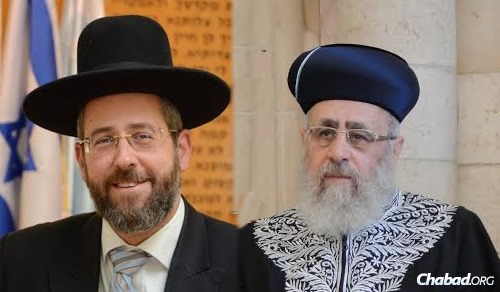 |
| The Chief Rabbis of Israel—Rabbi David Lau, left, and Rabbi Yitzchak Yosef—issued letters calling for observance of the Lubavitcher Rebbe’s yahrtzeit. |
In preparation for the 20th yahrtzeit (anniversary of passing) of the Lubavitcher Rebbe—Rabbi Menachem M. Schneerson, of righteous memory—on the third of the Jewish month of Tammuz, corresponding to this coming Tuesday, July 1, the chief rabbis of Israel have publicly called for worldwide commemoration of this day with increased mitzvah observance.
Sephardic Chief Rabbi Yitzchak Yosef called upon “each and every person to continue [the Rebbe’s] vision and carry out his directives,” enumerating that on the day of the yahrtzeit, people should “set aside time to study the Torah and Jewish law, enhance our prayers, increase our charity, perform random acts of kindness and draw our brethren near.”
Chief Ashkenazic Rabbi David Lau issued a call for “increased vigor in the perpetuation of his legacy,” explaining the unique relevance of the Rebbe’s yahrtzeit to all Jews by citing the Talmudic sages’ as saying, “The righteous are considered alive even after their passing.”
Although “20 years have passed [since the Rebbe’s passing],” Lau said, “the impact of the Rebbe's legacy is tangibly felt throughout the world,” and his work “bears increasingly more fruit with each passing day ... as Torah and Jewish identity are continually strengthened.”
Lau further cited age-old Jewish teachings, noting that “the unique role of a tzaddik—a righteous person of spirit—is to strengthen the bond between G‑d and Man.”
Explaining this in earthly terms, Yosef said that the Rebbe was a “Jewish leader of towering stature who lived a remarkable life,” who “kindled the flame of faith” and “guided thousands of Jews [to] return to their roots.”
Yosef also lauded the Rebbe’s prodigious Torah scholarship, writing that both he and his father—Chief Rabbi Ovadia Yosef, of blessed memory—quoted the Rebbe’s opinions in their books and “deeply analyzed his holy words.”
“The Rebbe worked tirelessly to unite all segments of Jewish society,” Yosef continued, and “words cannot describe his self-sacrifice on behalf of all Jews, whether on an individual or communal level.”
Rabbinic groups from the United States to Australia have similarly called upon rabbis to dedicate their Shabbat sermons this week to discussing the Rebbe’s legacy of unconditional love and scholarship.
The National Council of Young Israel cited the “the Rebbe’s erudition and unparalleled dedication to outreach” and his “continued unique impact” in calling upon its member congregations’ rabbis to dedicate this coming Shabbat “to help our congregants reflect on the passing of this Torah giant.” The council also offered a number of sermon ideas on the topic.
The Rabbinical Council of America sent out suggestions of resources on the subject to its member rabbis, and local rabbinic groups like the Chicago Rabbinical Council and the Organisation of Rabbis of Australasia also issued similar calls.
Many other prominent Israel rabbis who are part of the council of the Chief Rabbinate, such as the chief rabbis of Safed, Holon, Mevasseret Tzion, Kiryat Ono, Beersheva, Midgal Ha’Emek, Haifa and Givatayim, and the rabbinical advisor to the Israel Defense Force, amplified the chief rabbis’ call as well.
Letter penned by Israel's Sephardic Chief Rabbi Yitzchak Yosef and signed by 10 other leading rabbis
Letter penned by Israel's Ashkenazic Chief Rabbi David Lau
• Q&A: New Online Works Offer Insight Into the Rebbe’s Scholarship (By Menachem Posner)
 |
| Pages from one of the Rebbe's personal journals. |
As the 20th yahrtzeit (anniversary of passing) of the Rebbe—Rabbi Menachem M. Schneerson, of righteous memory—draws near, print and electronic media have been awash with content devoted to his immense contributions to and influence on Jewish life in the 20th century and into the 21st.
As part of the broader relaunch of TheRebbe.org, two Chabad.org team members have crafted new works that explore an area that has been less accessible to the wider public—how the Rebbe’s Torah scholarship and philosophy were intrinsic to his life and leadership.
Chabad.org editor Rabbi Yanki Tauber recently completed the first section of an upcoming monograph, The Rebbe’s Philosophy of Torah. Chabad.org research writer and editor Rabbi Eli Rubin produced Scholar, Visionary and Leader: A Chronological Overview of the Rebbe’s Life and Ideas. Here, they discuss these new online works.
What is the primary motive and goal behind each of these new works?
Tauber: We’ve all seen many assessments of the Rebbe’s impact on the Jewish community and beyond as a leader and a visionary, but I felt that there could be more emphasis on his unique approach to Torah scholarship. What I set out to do is to try and demonstrate the underlying themes and ground-breaking approach that characterize the Rebbe’s prodigious output of Torah teachings.
Rabbi Yanki Tauber
For example, the section titled, The Divine and the Human in Torah, discusses the Rebbe’s approach to the human-Divine partnership that defines Torah. On one hand is the notion that every nuance of Torah is G‑d’s wisdom that cannot be altered. Yet our understanding of the written and oral Torah is very much the cumulative product of thousands of years of human creativity, too. I’ve tried to show how the Rebbe blends two seemingly disparate axioms together into a cohesive philosophy.
Rubin: The goal of Scholar, Visionary and Leader is to highlight some of the central events and ideas that together make him so uniquely influential, both in terms of activism and leadership, and in terms of scholarship and philosophy. The product is 28 articles, each one encapsulating a period of the Rebbe’s life and highlighting a key idea or theme that characterizes it.
The entry covering the years 1927 to 1932, for instance—a period during which the Rebbe attended the lectures of Erwin Schrödinger at the University of Berlin—provides an analysis of how the Rebbe used the new developments in quantum theory to articulate his approach to science and Torah.
Other topics include the Rebbe’s youth and upbringing in Yekatrinoslav, his marriage to the Rebbetzin, his approach to faith in the face of the Holocaust, his vision of America as a place of religious opportunity, his focus on empowering individuals, his efforts and policies vis-à-vis Soviet Jewry, and the responsibility Jewish people have to all humanity.
Is there one theme that you think characterizes the Rebbe’s life and ideas?
Rubin: The Rebbe’s communal policies and Torah scholarship are both marked by his vision of the Torah as a unified blueprint that illuminates everything. To my mind, what characterizes the Rebbe’s approach on every issue is his concern that the light of Torah continues to illuminate lives. It is therefore impossible to separate the Rebbe’s Torah scholarship and philosophy from his vision and leadership.
One thing that both Yanki and I keep coming back to is the theme of unity. Too often, unity is devalued; it’s turned into a cliché, or used to cover up differences and ignore them. But for the Rebbe, unity was the prism through which he saw everything. It was his mission to lay bare the singular essence that is the true core of all the complexity and dissonance of human experience. I can’t say I understand this; I don’t know if anyone understands it fully. But the more you study the Rebbe’s teachings and the more you study the Rebbe’s life, the more you see this.
There is one talk, later edited and published as an essay, On the Essence of Chassidus, in which the Rebbe definitively explained his unique vision of Chassidism and Torah. This is a text that is deeply profound, and the more you study it and restudy it, the more you see how it illuminates the entire corpus of the Rebbe’s ideas and teachings. More than explain what Chassidus is, he demonstrates how it works. He selects a Torah topic, analyzes it according to four classical forms of Torah interpretation and then shows you what happens when Chassidism discovers its essence.
In a similar way, it is very hard to explain why the Rebbe is so significant. But by presenting brief overviews of the Rebbe’s life and ideas, I am trying to show the reader something of the harmony that the Rebbe drew from the Torah into every area of life.
Can you offer some examples of how episodes or themes that you describe demonstrate the Rebbe’s unified perspective?
Tauber: The Rebbe’s approach to Talmud study can be described as a synthesis of the approach innovated by Rabbi Chaim Soloveitchik of Brisk with that of the Rogachover Gaon (Rabbi Yosef Rosen), with whom the Rebbe began corresponding as a teenager.
Brisk champions the understanding that fine lines can be drawn to differentiate laws and concepts that appear to be identical at the outset. On the other end of the spectrum, the Rogachover espouses the unity of Torah, teaching that a central unifying theme could be found in areas that appear to be completely unrelated.
The Rebbe drew from both. For example, he famously demonstrated how seven different disagreements between the schools of Hillel and Shamai all hinge upon a common, broader disagreement—and then went on to explain how each individual disagreement is unique.
Rabbi Eli Rubin.
Rubin: Two related examples come to mind. The first is the issue of science and Torah; the second is the issue of feminism and Torah. Even today, these issues remain extremely contentious and polarizing. What usually happens in these debates is that one person comes with one set of assumptions and another person comes with another set of assumptions, and each declares the other’s assumptions to be wrong. But the Rebbe didn’t do that; the Rebbe did exactly the opposite. The Rebbe actually put scientific and feminist assumptions to work in support of the Torah position.
What does this have to do with unity?
Rubin: It seems to me that the reason why the Rebbe was able to give scientific and feminist assumptions validity—without altering his vision of Torah in any way—is because the Rebbe believed that everything in the world stems from the unified core of Torah. In On the Essence of Chassidus, the Rebbe tells a story about his father-in-law, Rabbi Yosef Yitzchak of Lubavitch: On one of his journeys, he encountered several people debating Torah’s view of various theories of social governance, communism, capitalism, etc. When they asked his opinion, Rabbi Yosef Yitzchak said: “Being the ultimate truth and good, Torah includes all the good aspects of all the theories.”
The Rebbe believed that even things that are clearly wrong and contrary to Torah must have a core of truth upon which they stand. There are things that are true and good, and there are things that are distortions of truth and good. Inherently, it is only when their own truth is distorted that science or feminism can be misrepresented in terms that contradict Torah. Our job is to reshuffle things so that the good shines through. An article in this series is devoted to each of these topics, and I don’t do all the explaining I’ve done here. Instead, I just try to give a snapshot of the Rebbe’s approach, giving some perspective, but by no means the whole picture.
What are some of the sources that you drew on for your research?
Rubin: In addition to the Rebbe’s published works, including the many volumes of talks, correspondence and personal journals, I owe an immense debt of gratitude to the JEM (Jewish Educational Media) “My Encounter” team for the interviews they have conducted—and continue to conduct—with people who encountered the Rebbe at various stages in his life.
In addition to the historical corroboration of events from multiple witnesses and documents, and the many gaps that they have filled, JEM’s interview series also provides the very valuable element of human insight. You get to see how real people were touched in real ways.
Tauber: My most primary source is the more than 200 published volumes of the Rebbe’s works: the talks and Chassidic discourses he edited, the many transcripts of his talks produced by listeners, the copious correspondence that has been published so far, and scholarly notations (reshimot) in his personal journals that came to light after his passing.
In addition, there are my own memories from the more than 20 years of the Rebbe’s farbrengens (gatherings) that I attended, starting as a child. Although the Rebbe was addressing Jewish scholarship of a very high caliber at these gatherings, everyone was there—men, women and children of all ages and backgrounds. Toddlers would be there sitting on their fathers’ laps. Everyone absorbed something on their level. Beginning at the age of 10 or 11, I began to retain significant ideas from the Rebbe’s talks, and that continued until 1992.
For the past 25 years, I have devoted a significant part of my working life to authoring treatments of the Rebbe’s teachings. To compile this work, I’ve drawn on the hundreds of articles I have written in the past. In a way, this is an attempt to draw it all together into a cohesive picture of the Rebbe’s unique understanding and application of Torah.
What are some of the most important things you hope a reader will take away from your work?
Rubin: My hope is that people will take these articles and run with them. They are all footnoted, giving the reader plenty of scope for further study, and there really is so much more on every one of these topics, and so many more topics besides. So I hope scholars and laypeople alike will be inspired to delve ever deeper into the Rebbe’s ideas, and try to emulate something of the way he lived and taught. Thank G‑d so many of the Rebbe’s talks and letters have been published. Especially insightful, but woefully understudied, are his personal journals from the years before he became Rebbe. JEM has also published many videos of the Rebbe’s talks and personal interactions. No one can say that there is not enough material. We all have a lot more to learn, a lot more to think about and a lot more to do.
Tauber: A better understanding of the Rebbe, of the Torah, and how Torah is the foundation of life.
-------
 Saint Louis, Missouri, United States -Daily Devotions from Lutheran Hour Ministries by Pastor Ken Klaus, Speaker Emeritus of The Lutheran Hour"Self-Healing" Tuesday, 1 July 2014
Saint Louis, Missouri, United States -Daily Devotions from Lutheran Hour Ministries by Pastor Ken Klaus, Speaker Emeritus of The Lutheran Hour"Self-Healing" Tuesday, 1 July 2014  who say that I, quite unfairly, have been picking on them. They assure me that if I have gone to a dentist who has given me more than a modicum of pain, I have been going to the wrong dentist.
who say that I, quite unfairly, have been picking on them. They assure me that if I have gone to a dentist who has given me more than a modicum of pain, I have been going to the wrong dentist.  In Christ I remain His servant and yours,
In Christ I remain His servant and yours, 